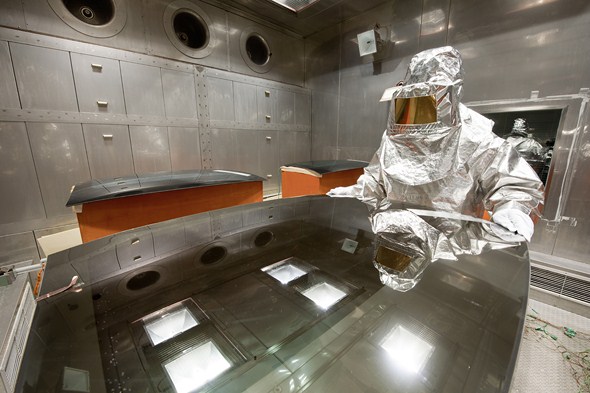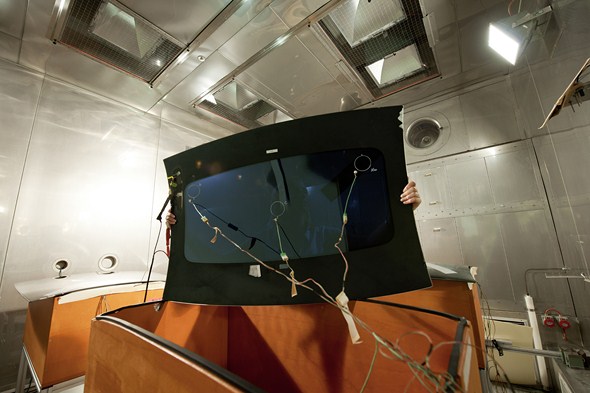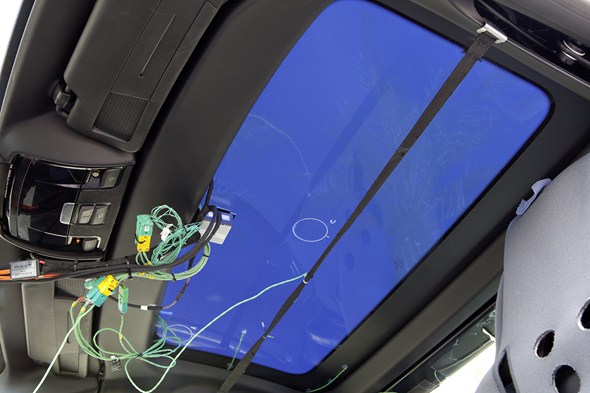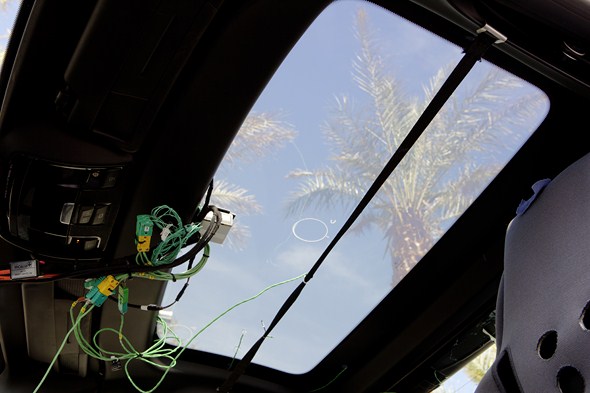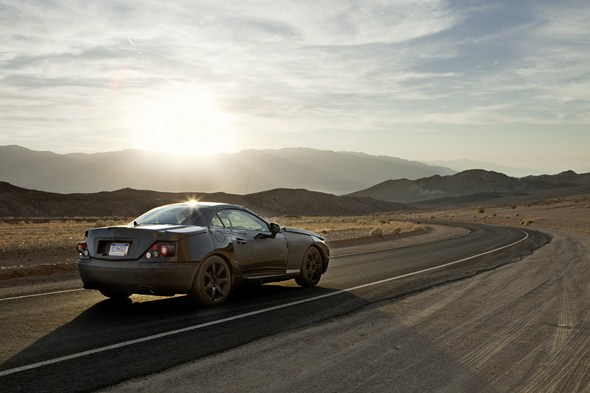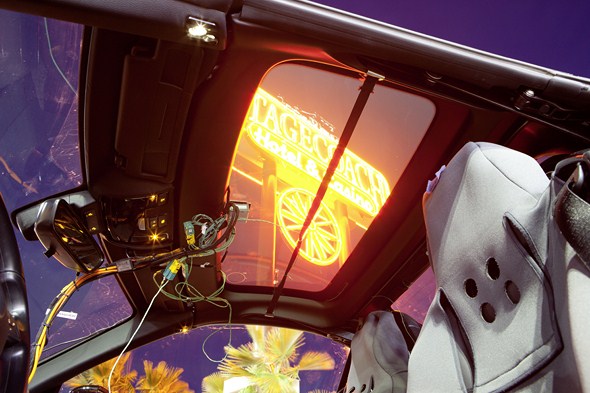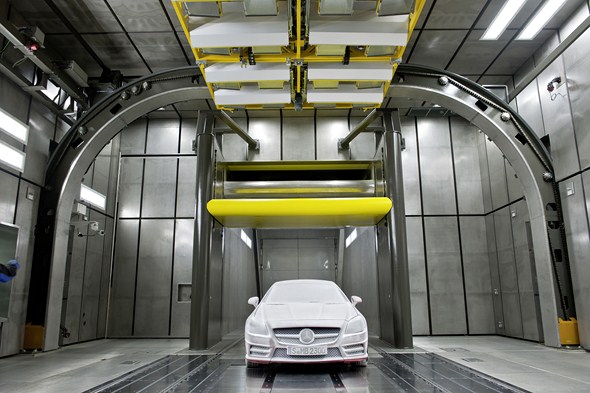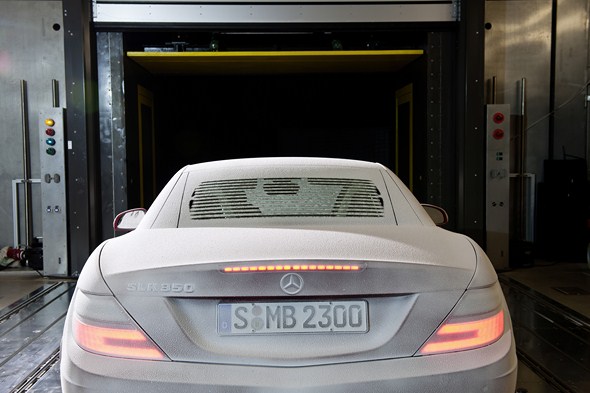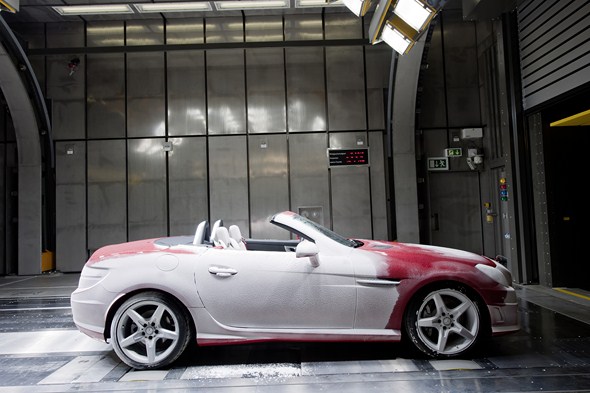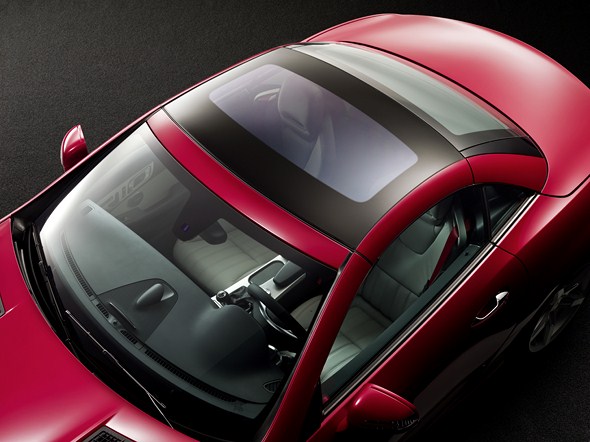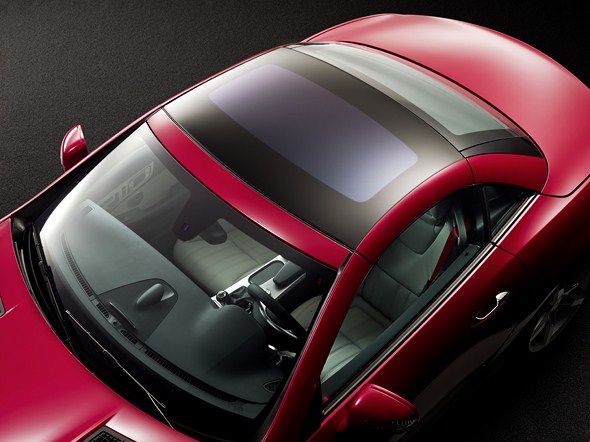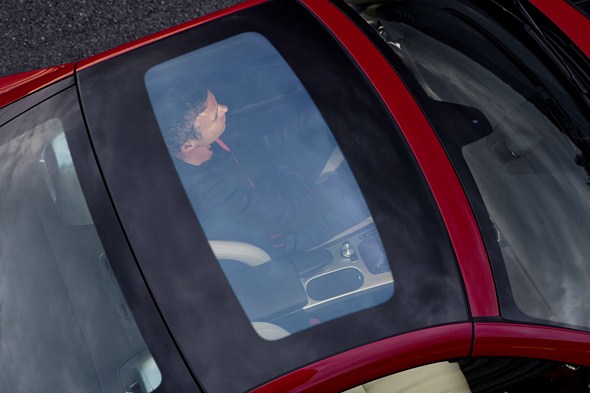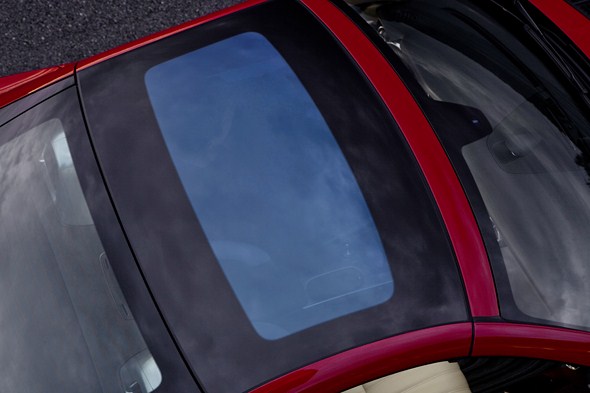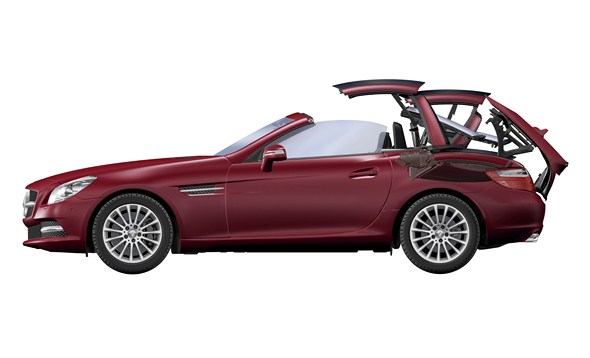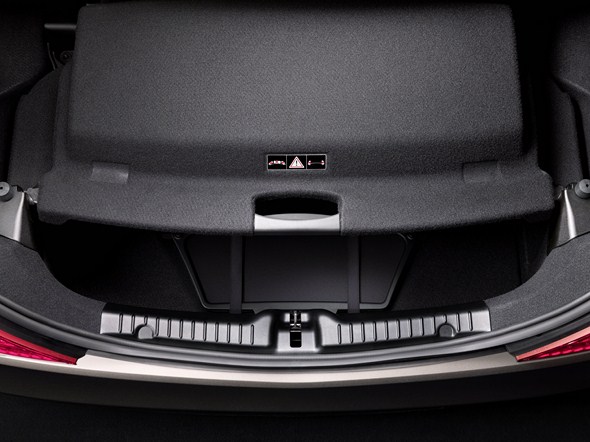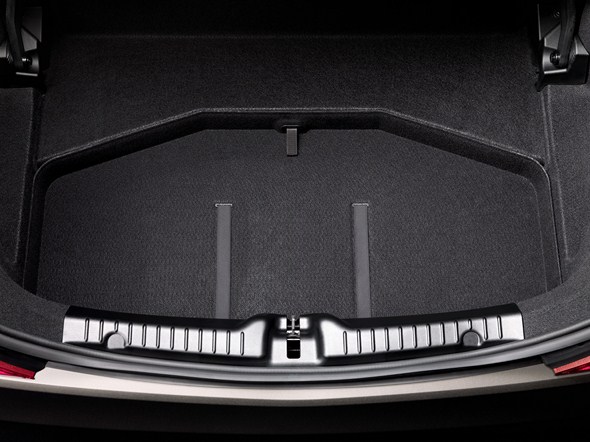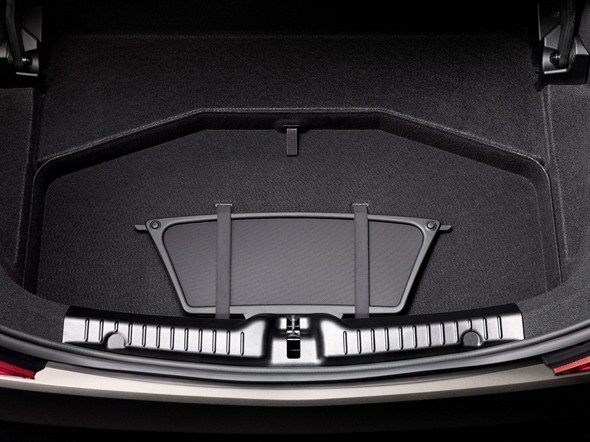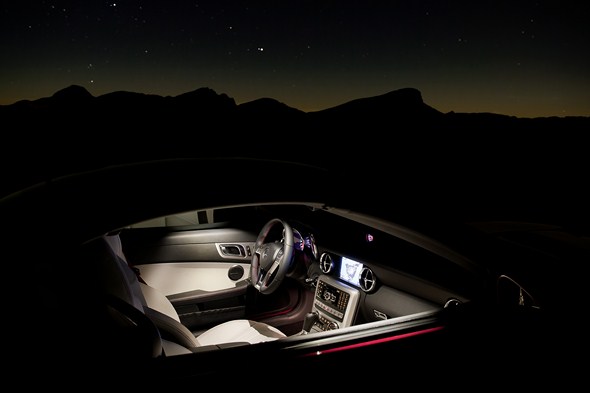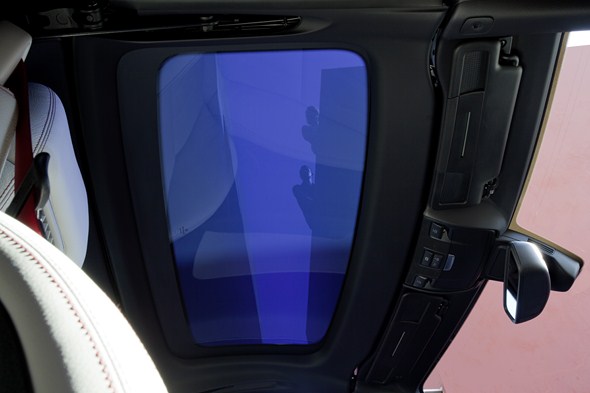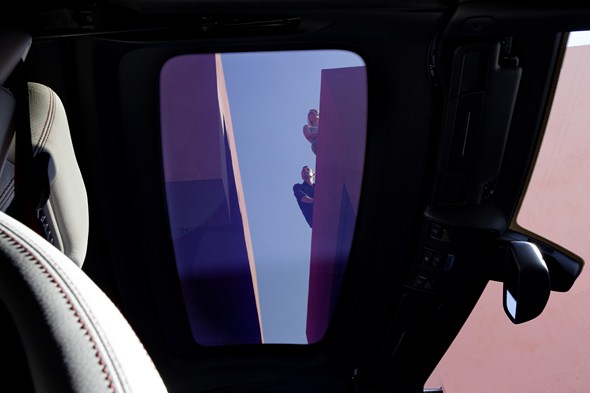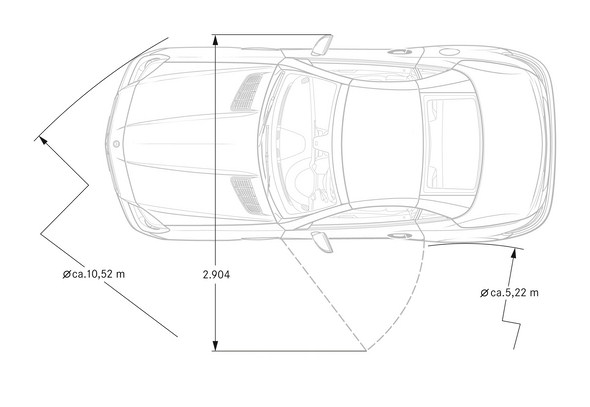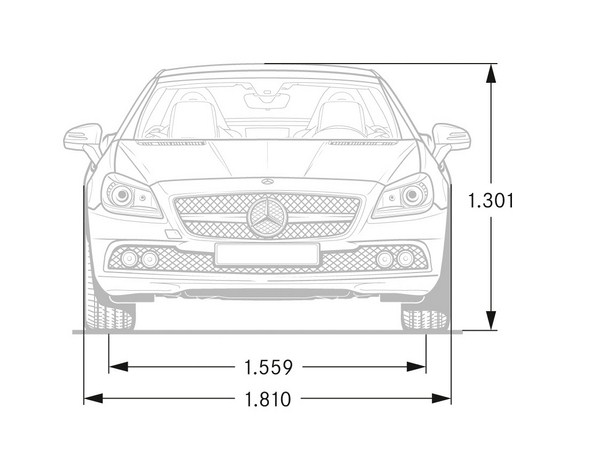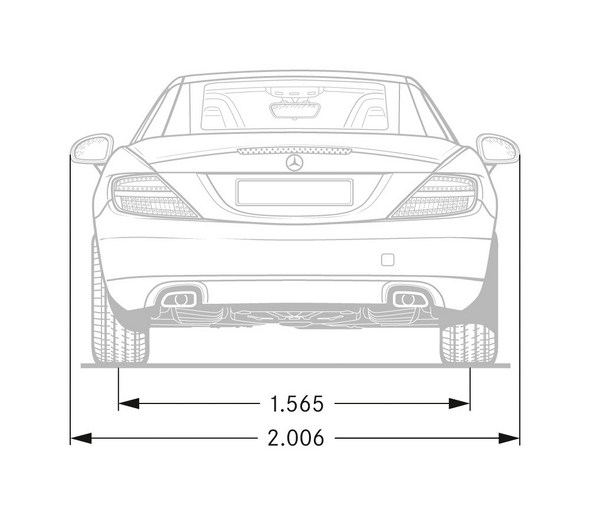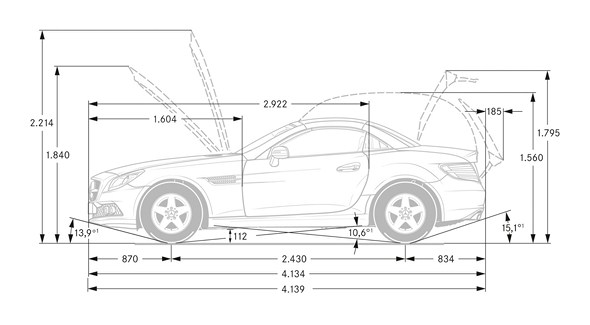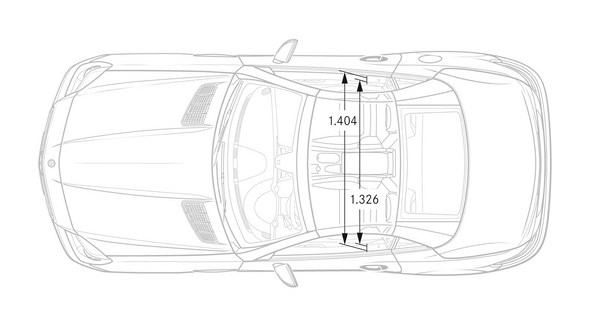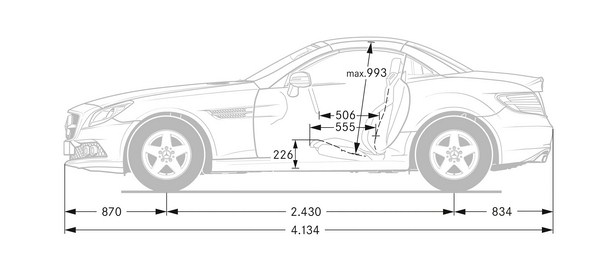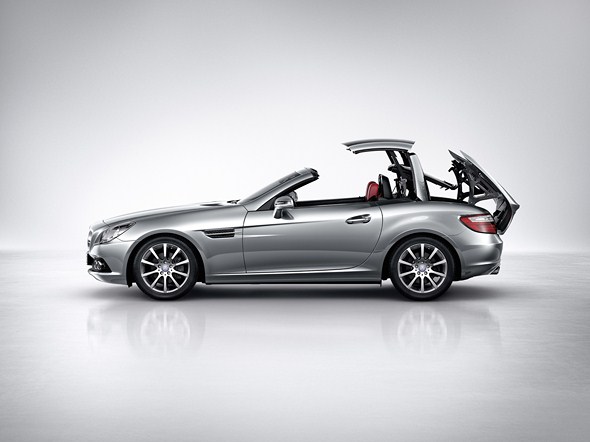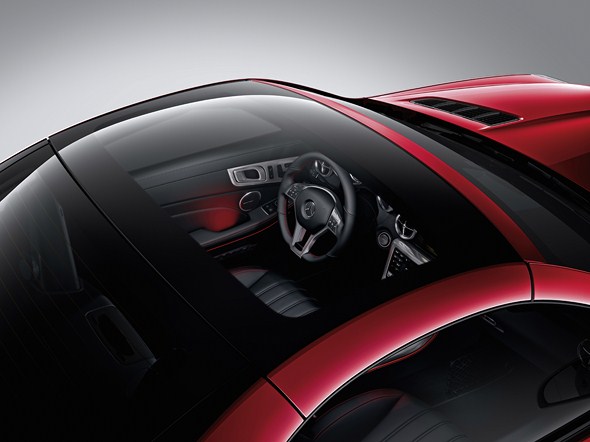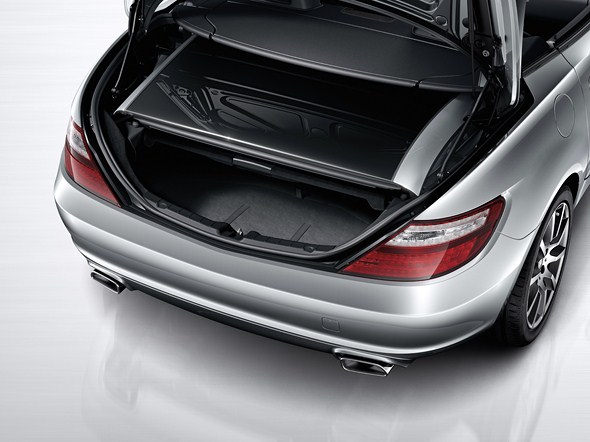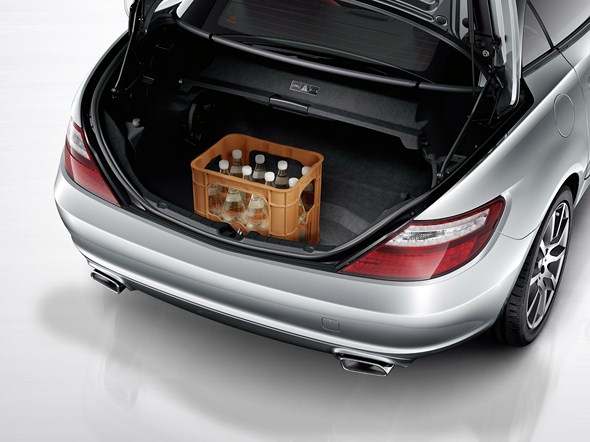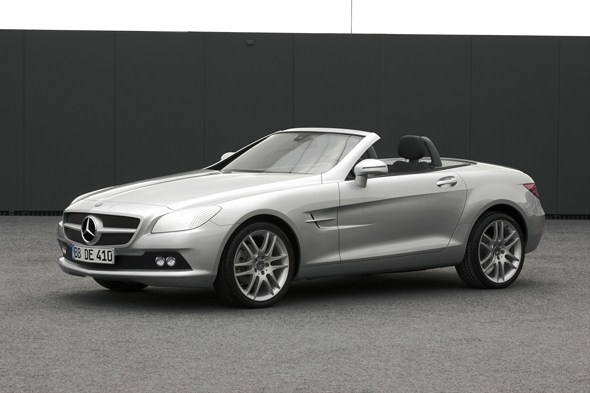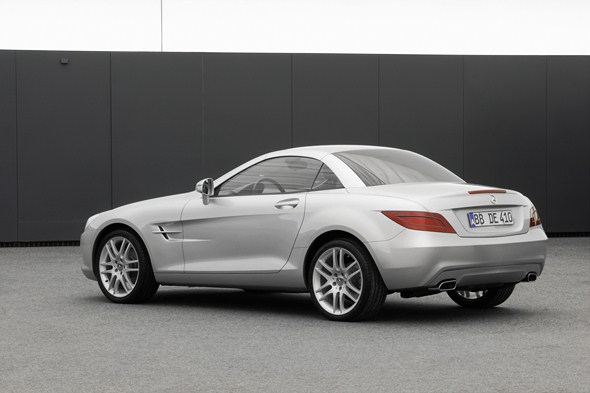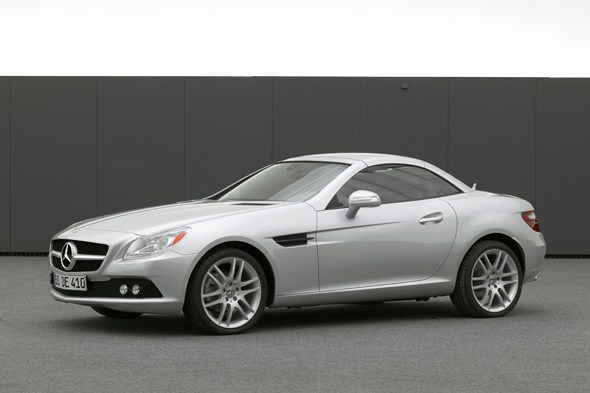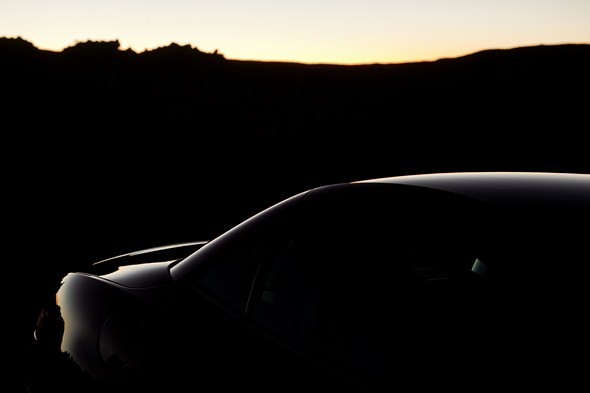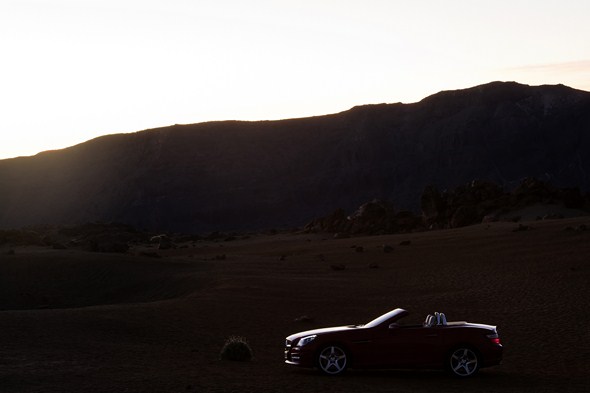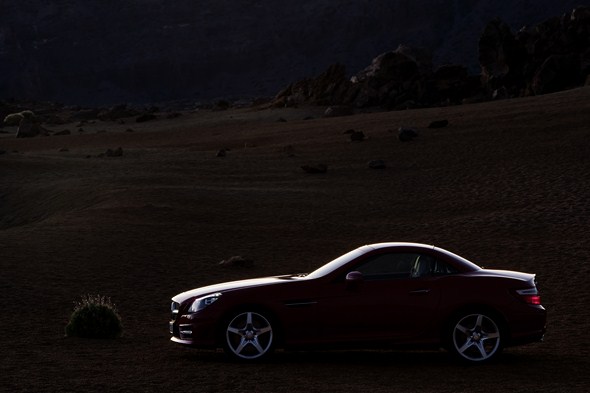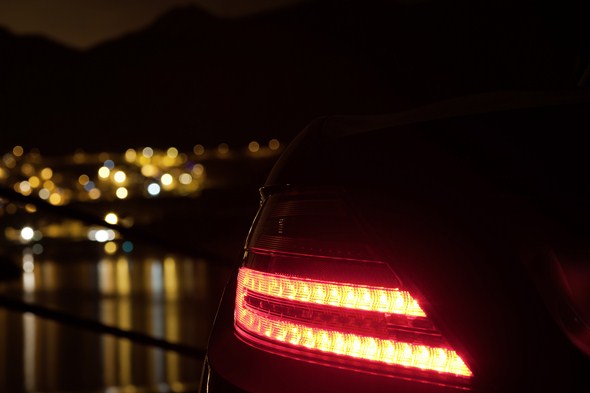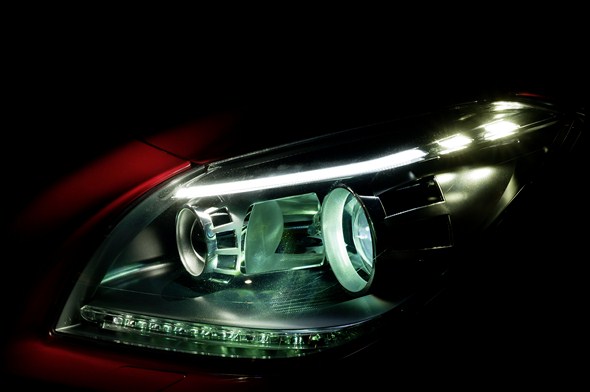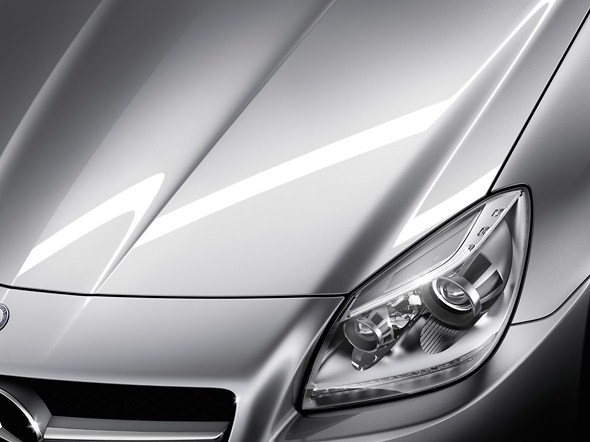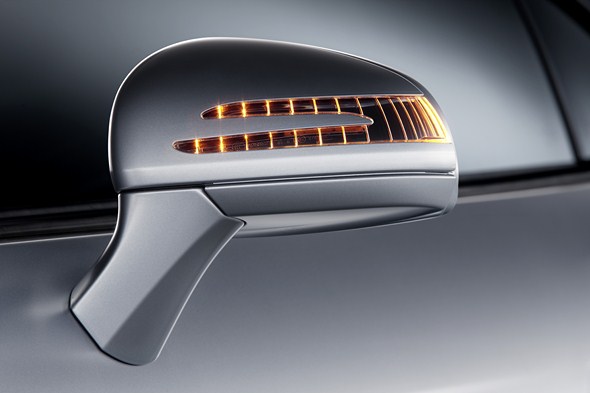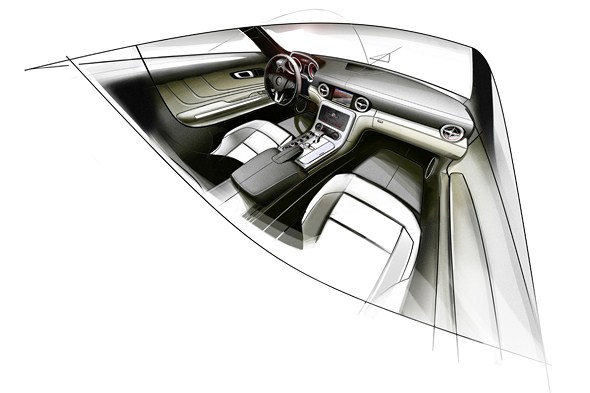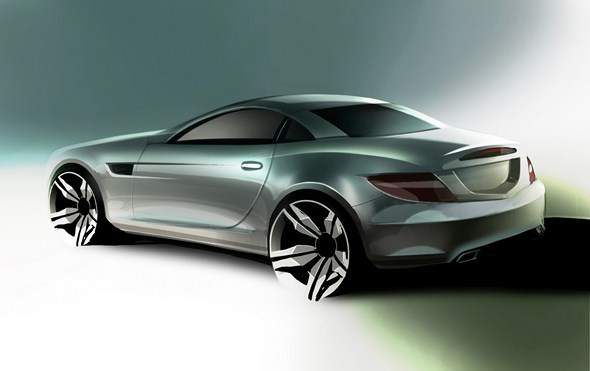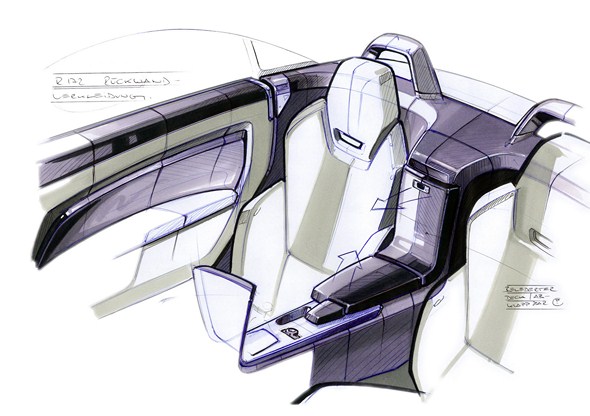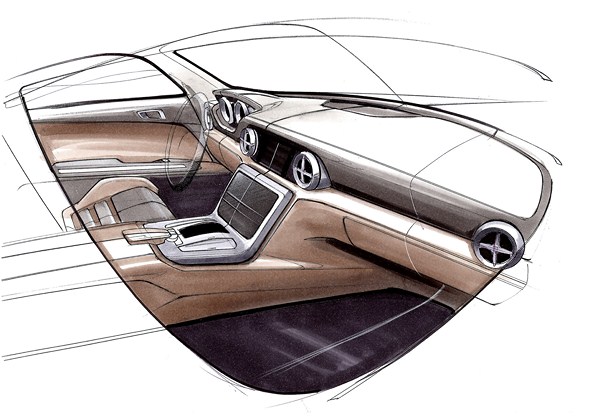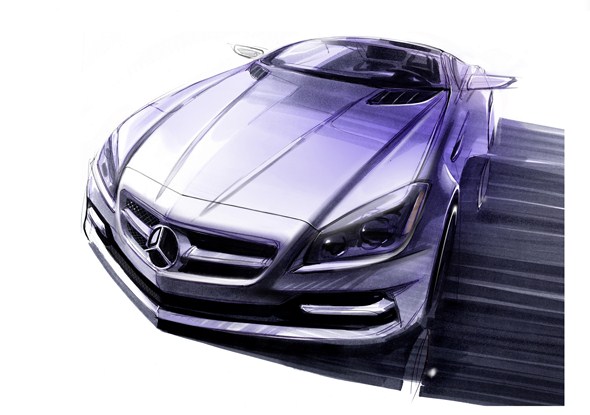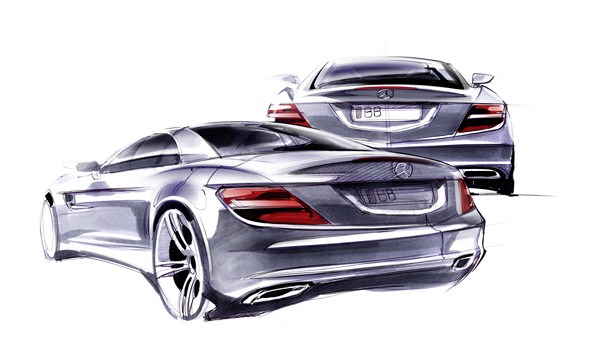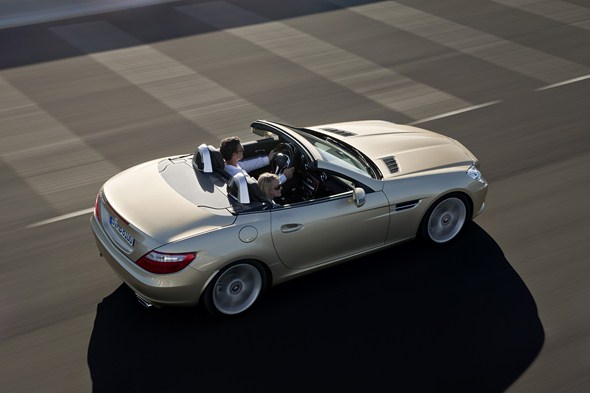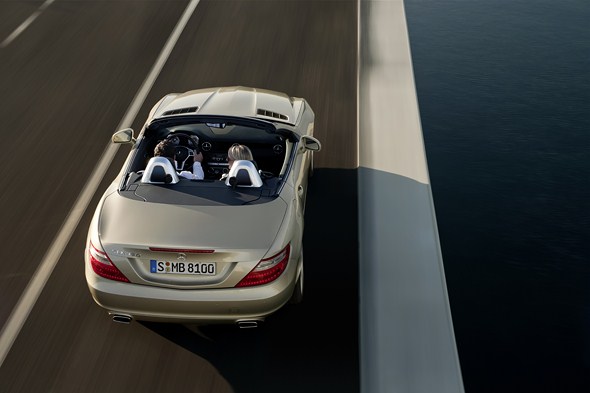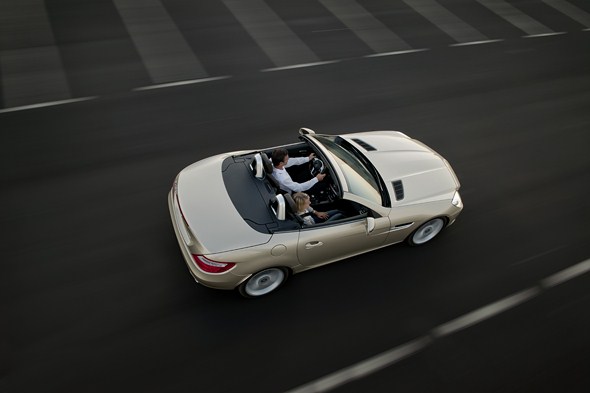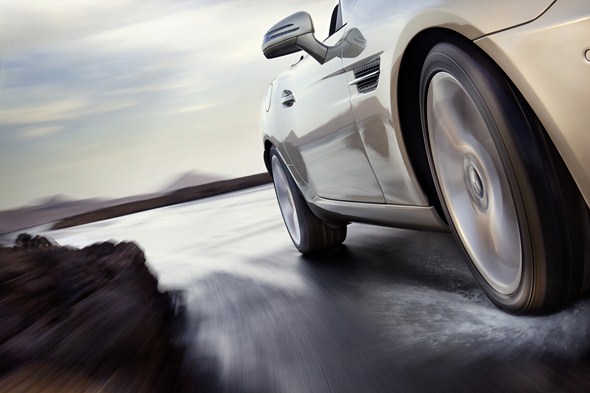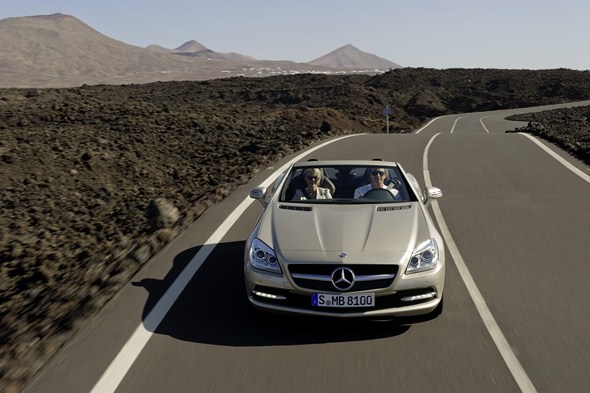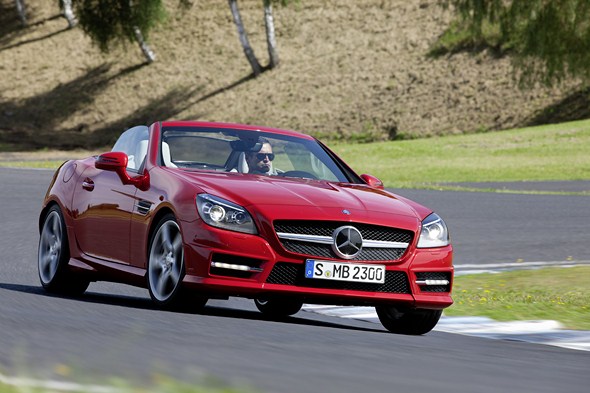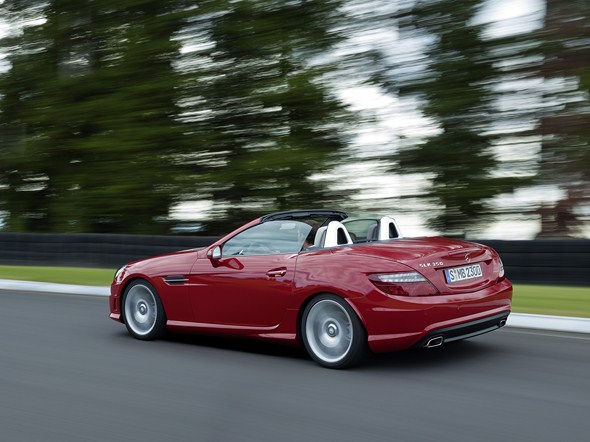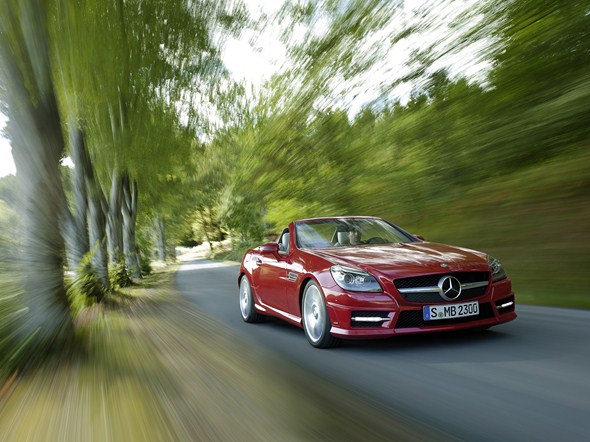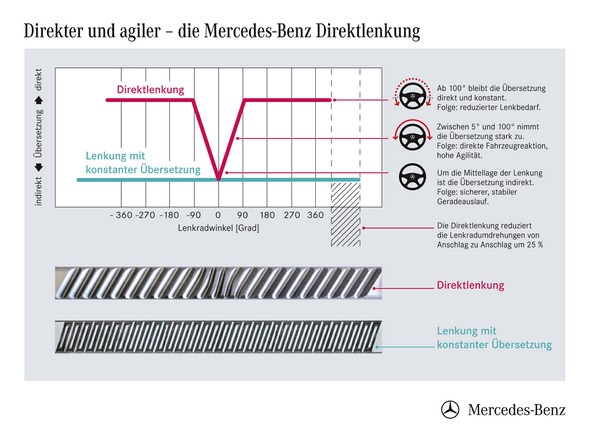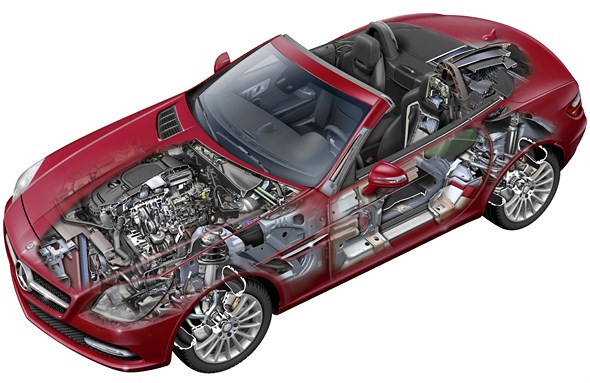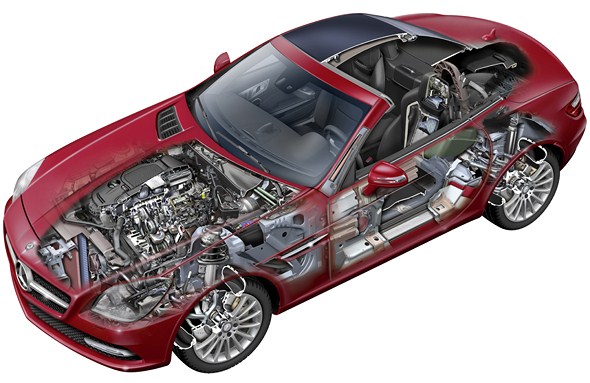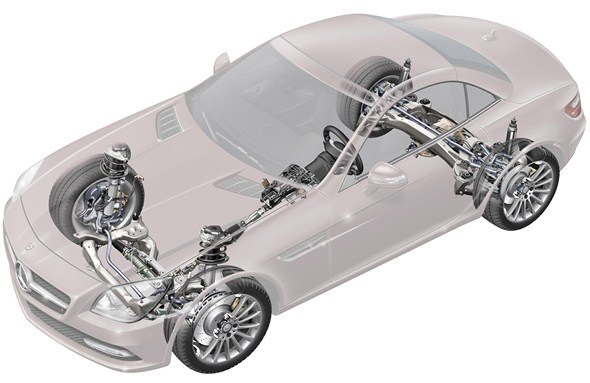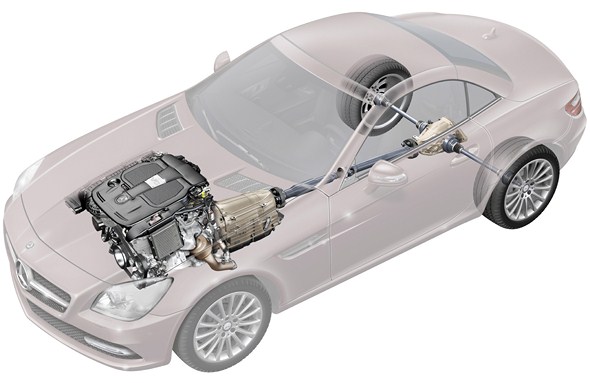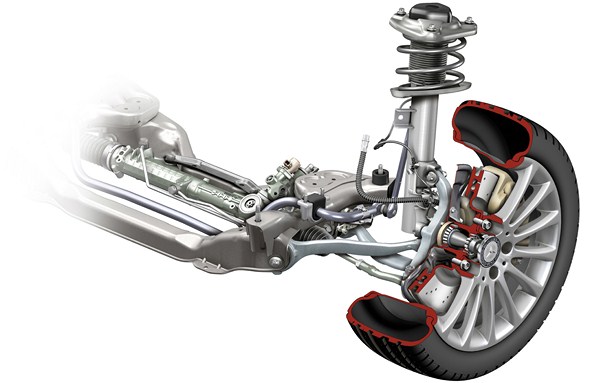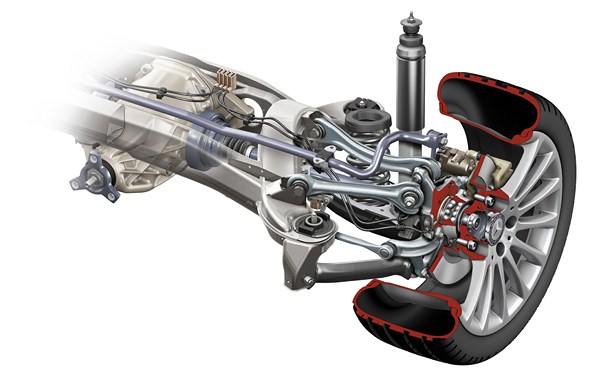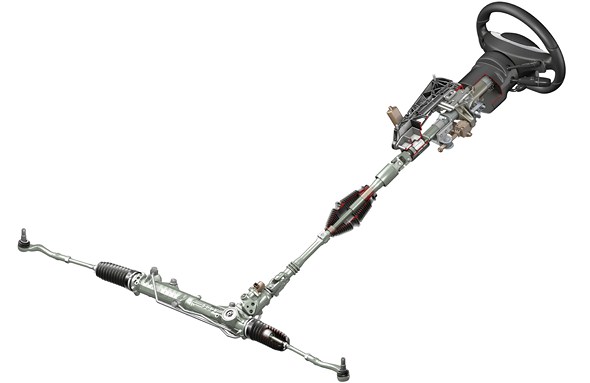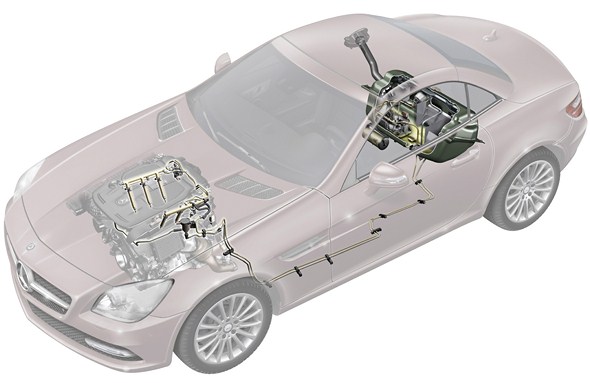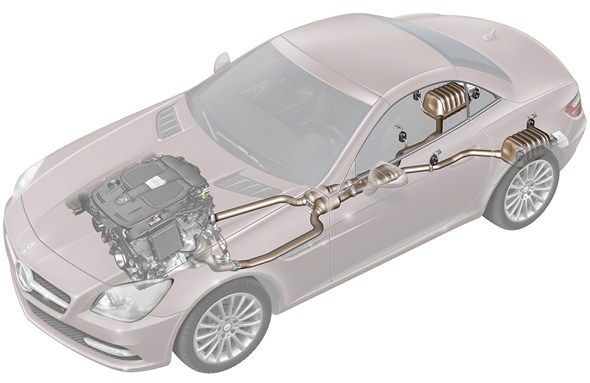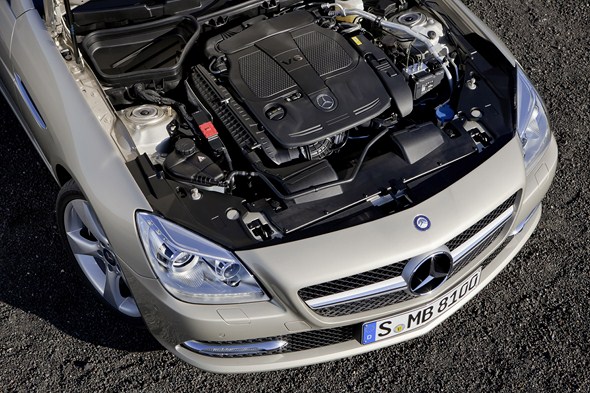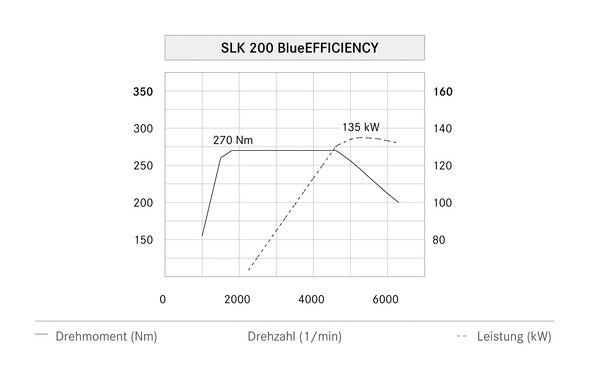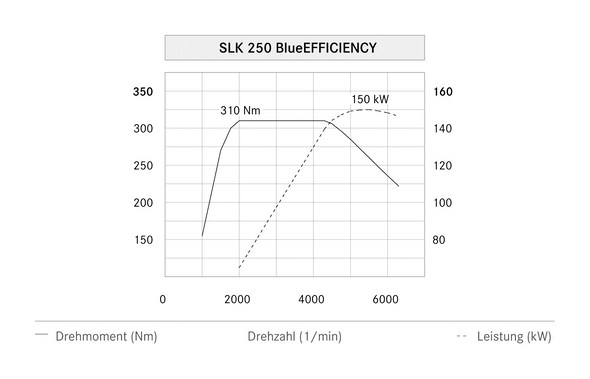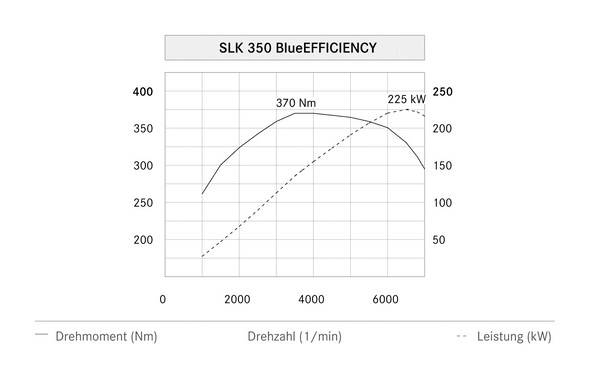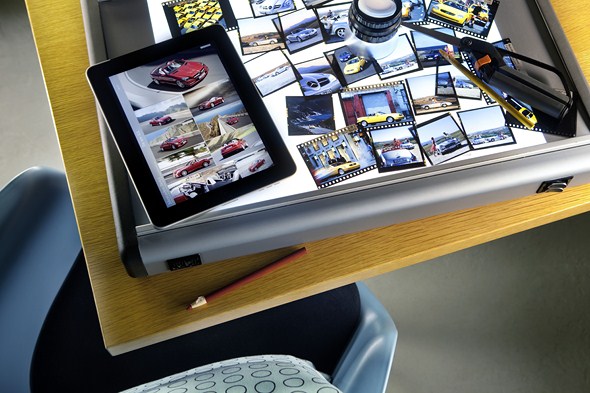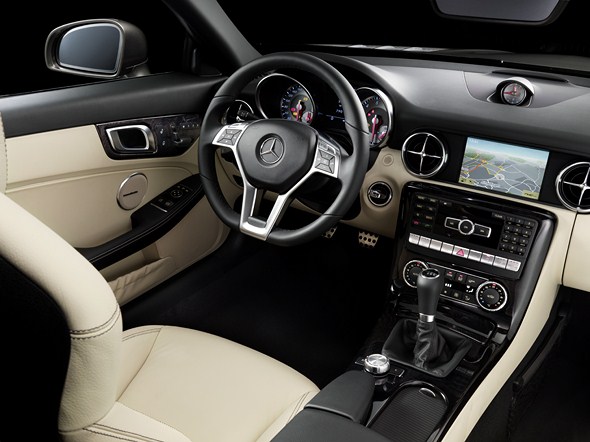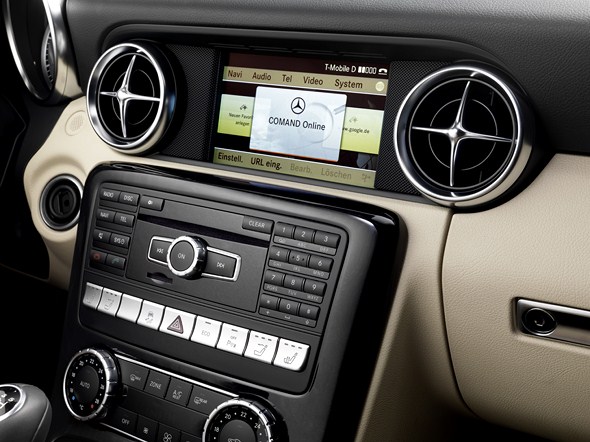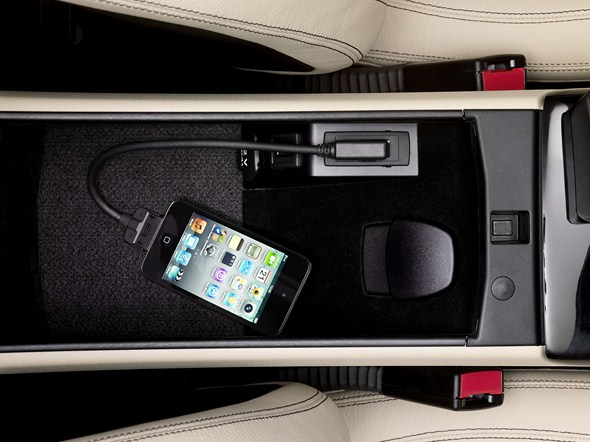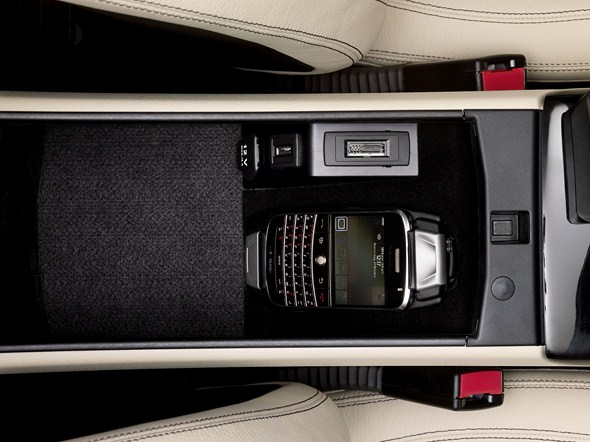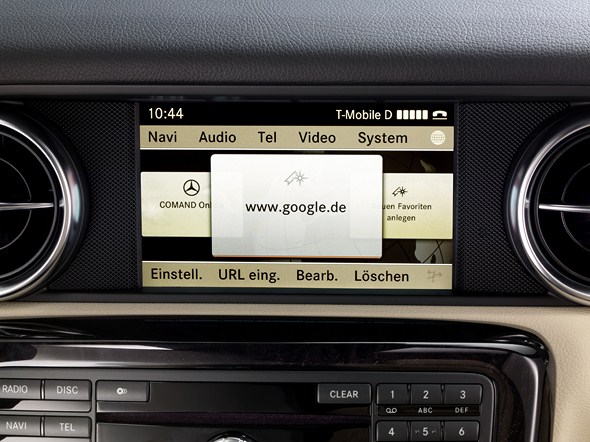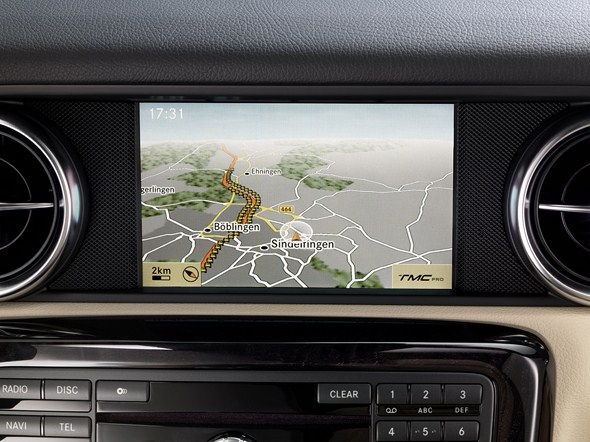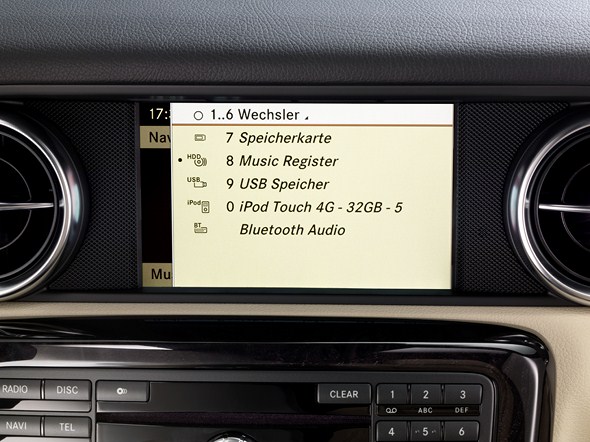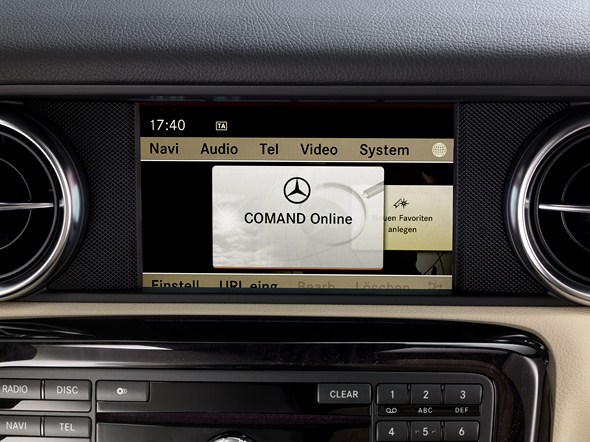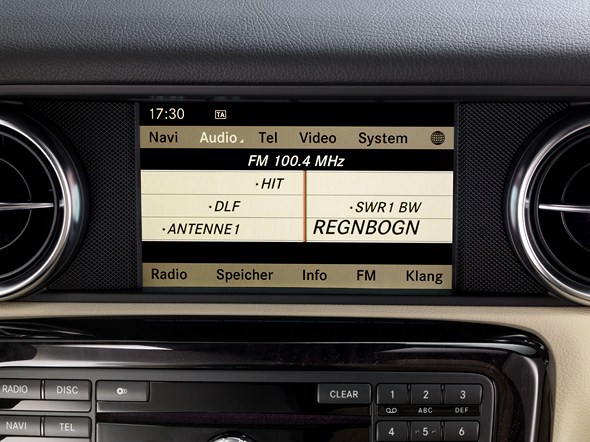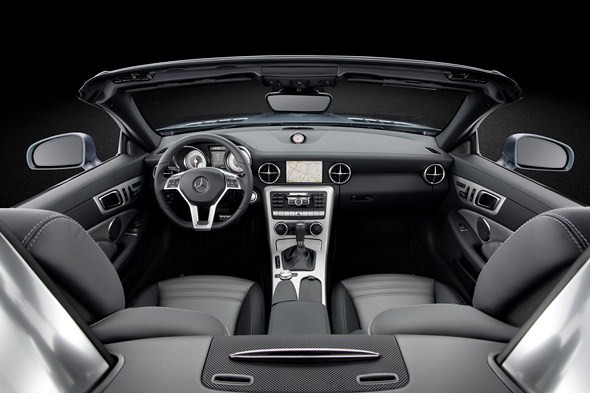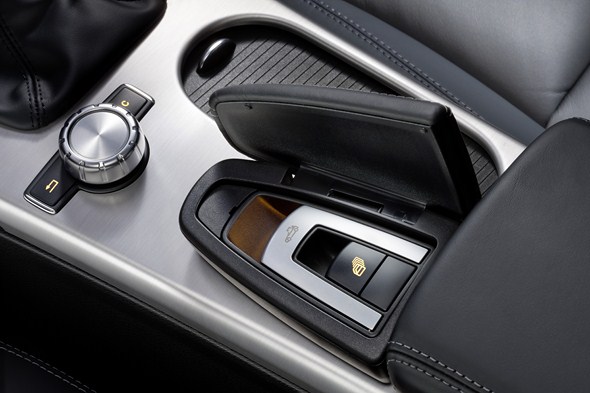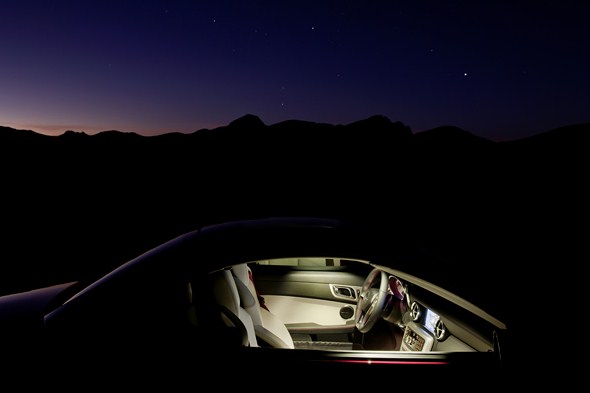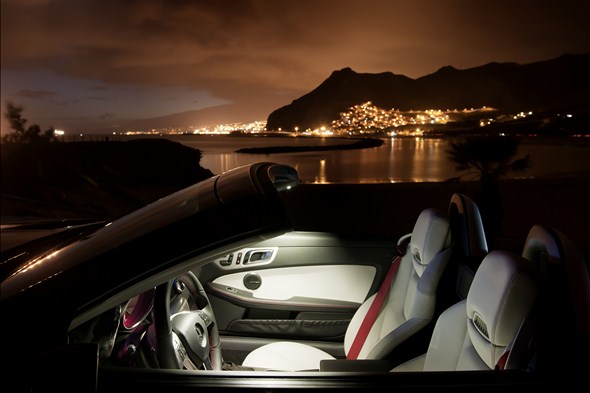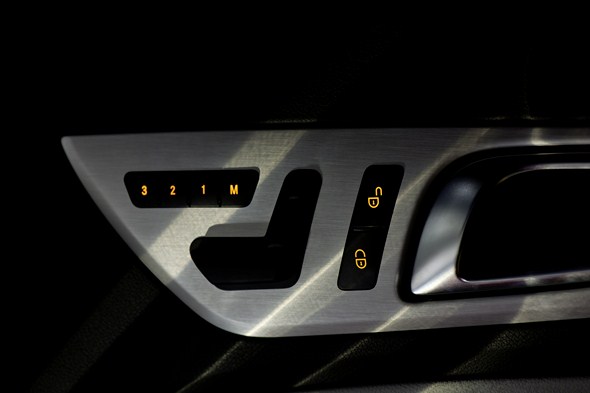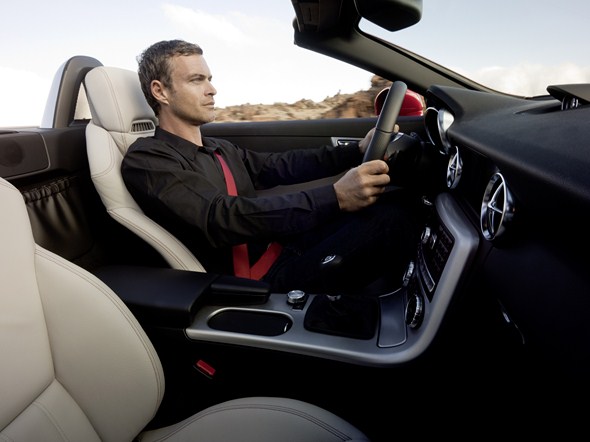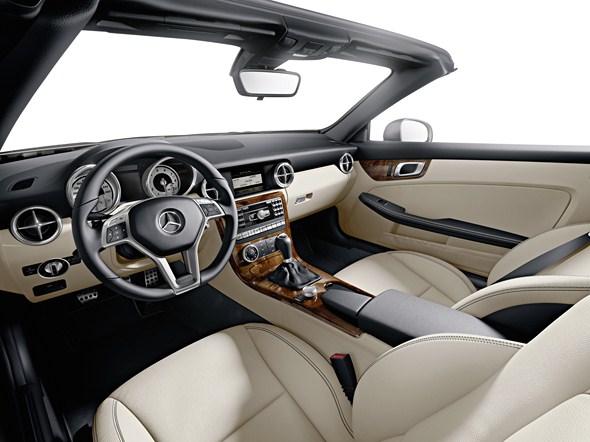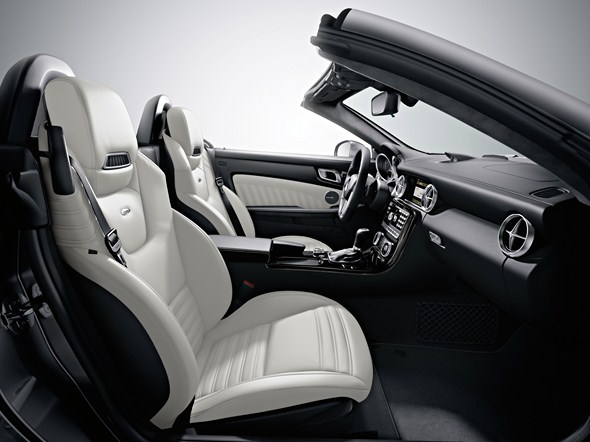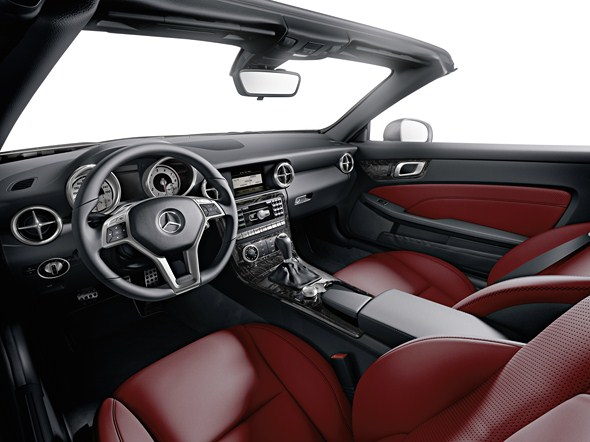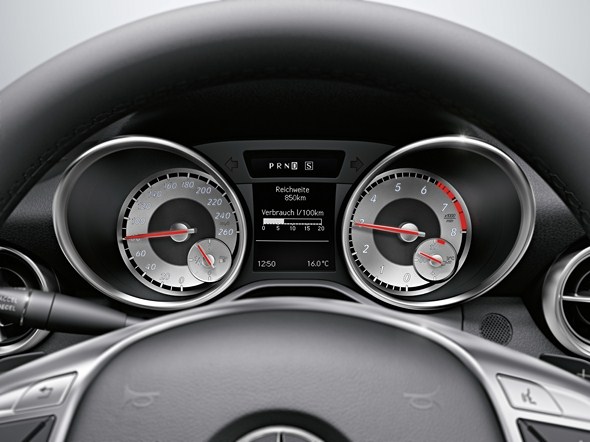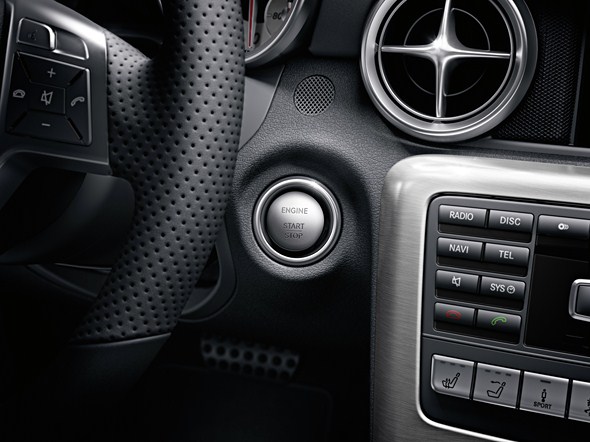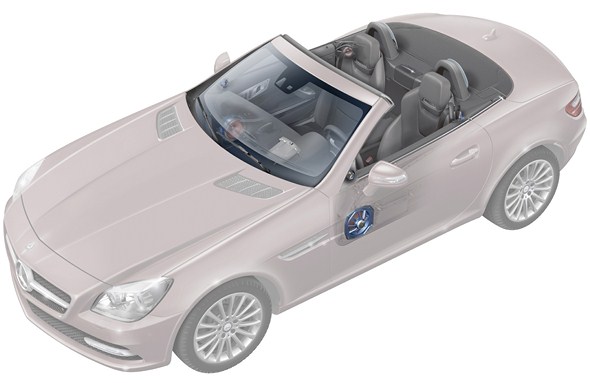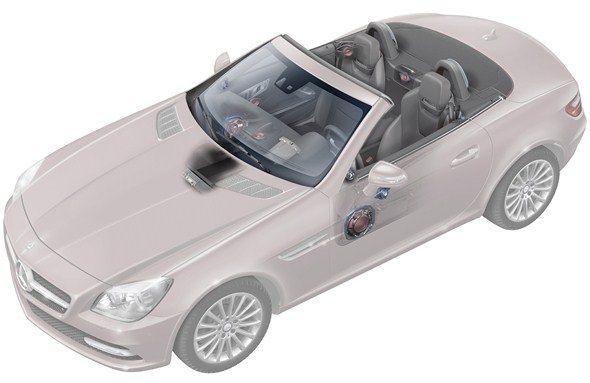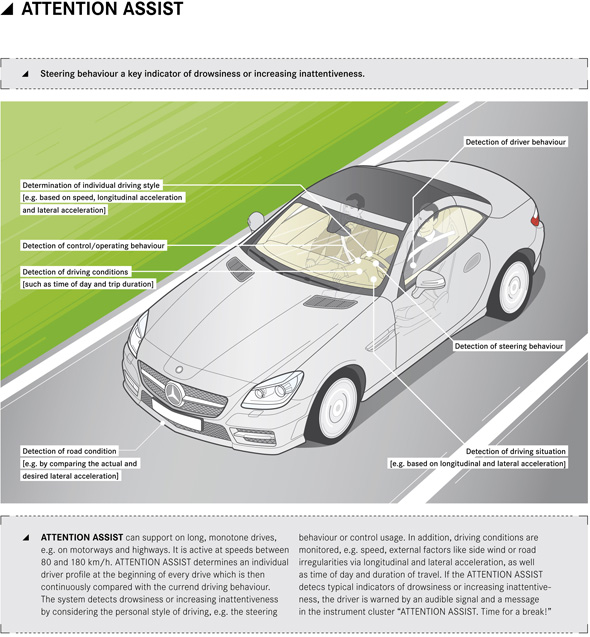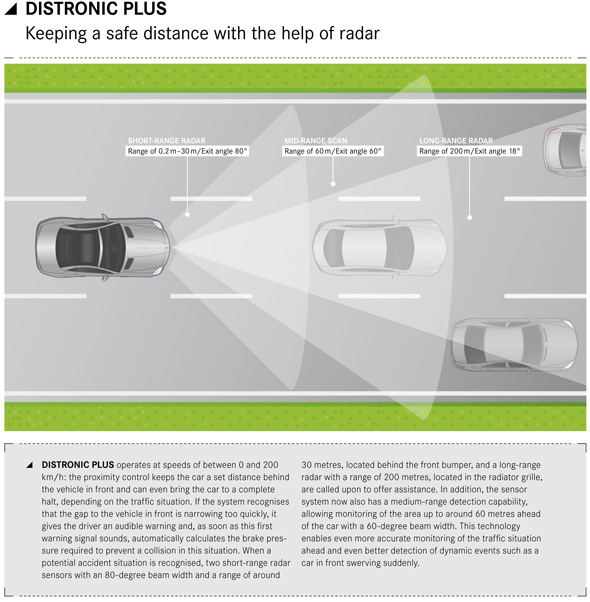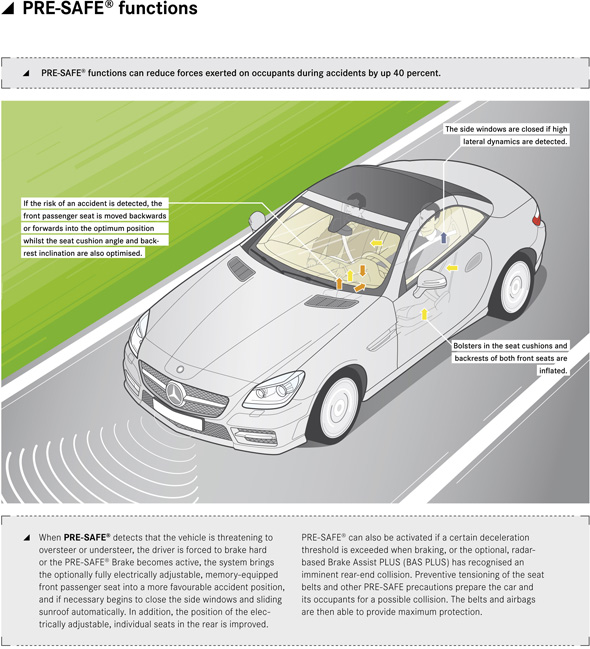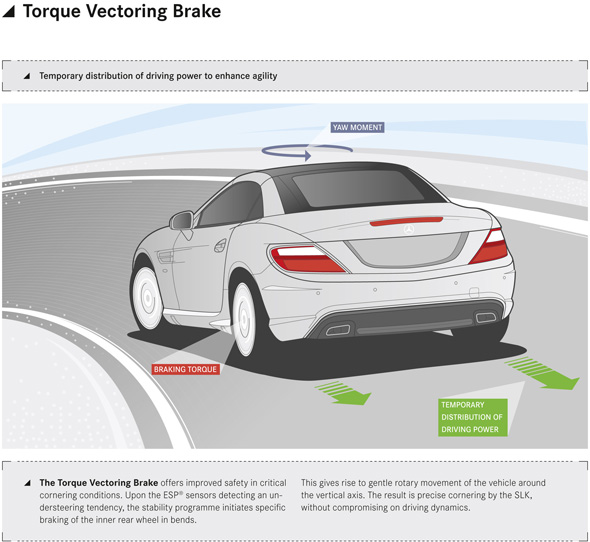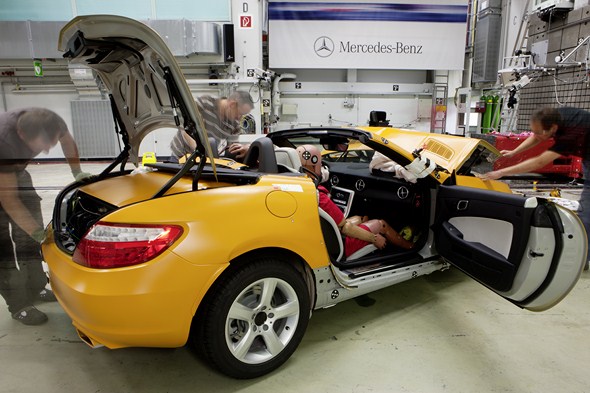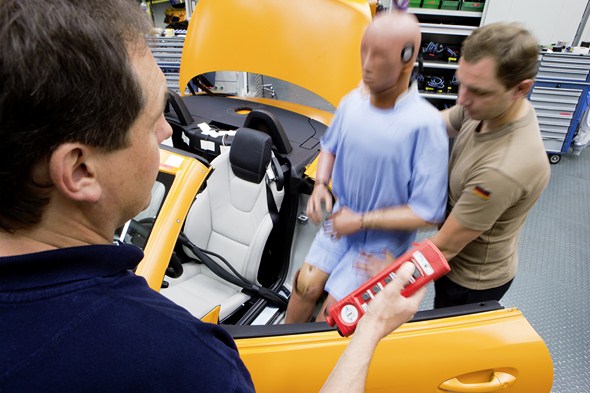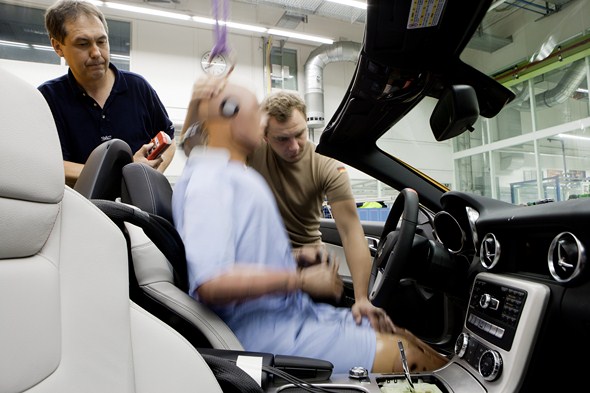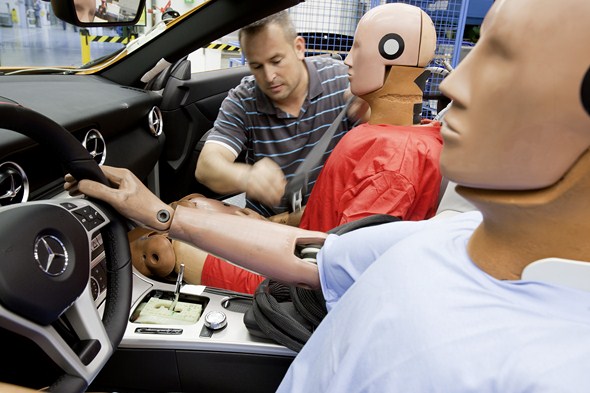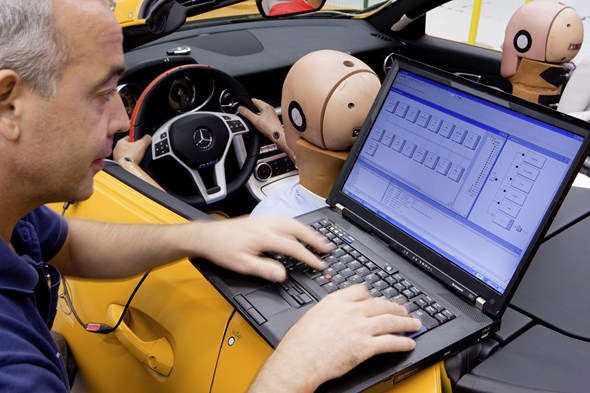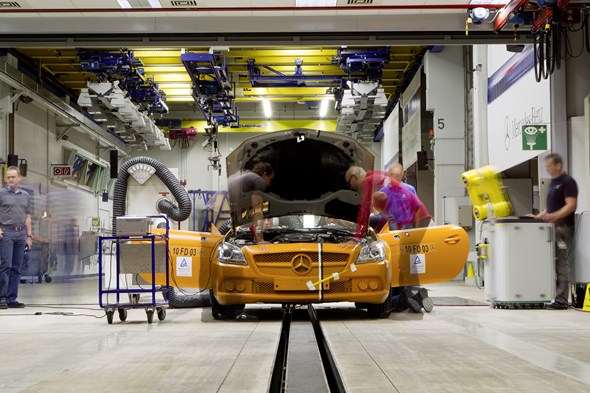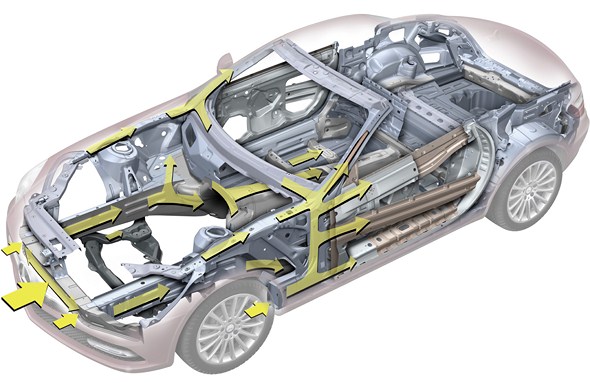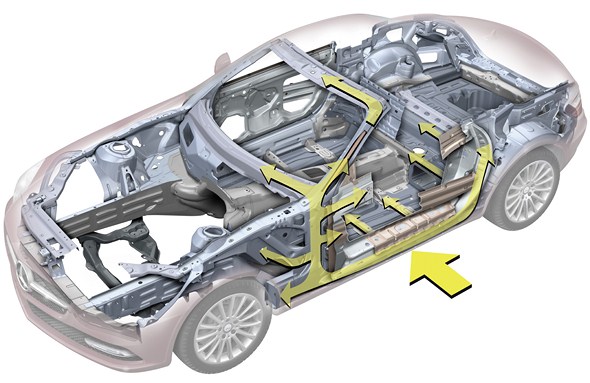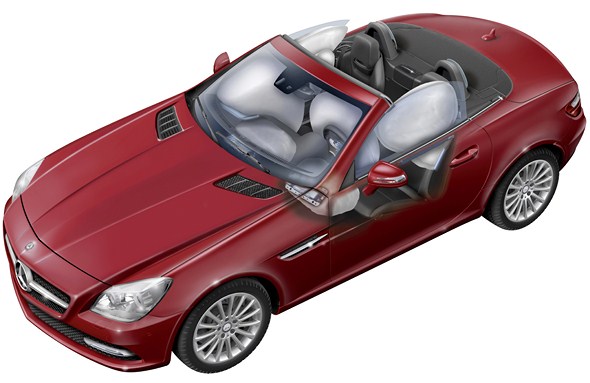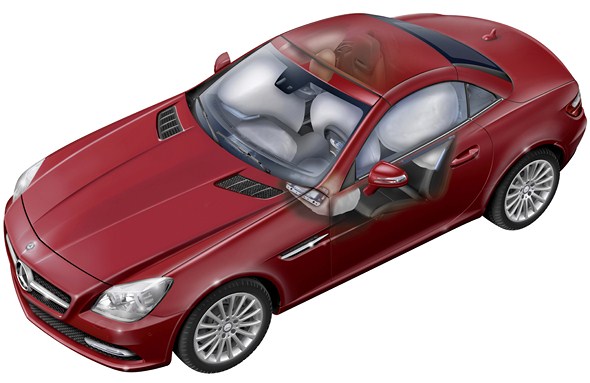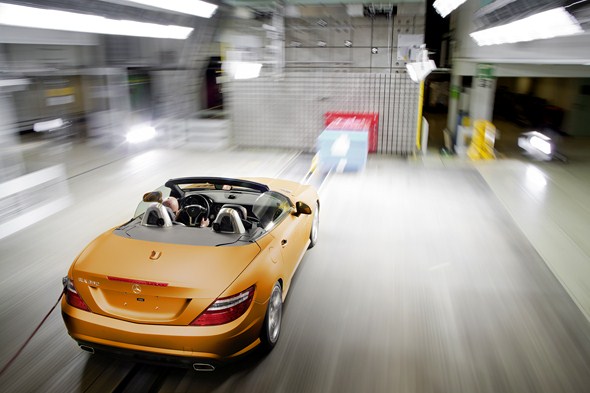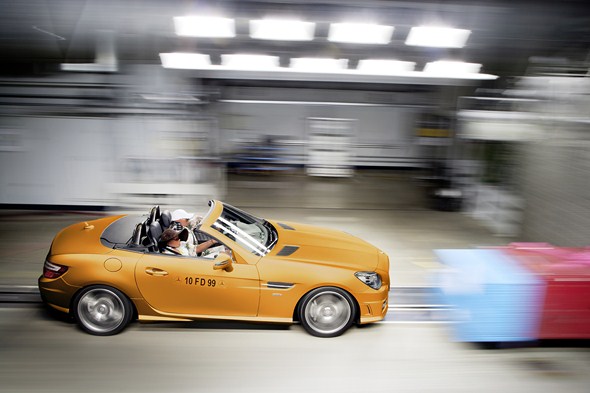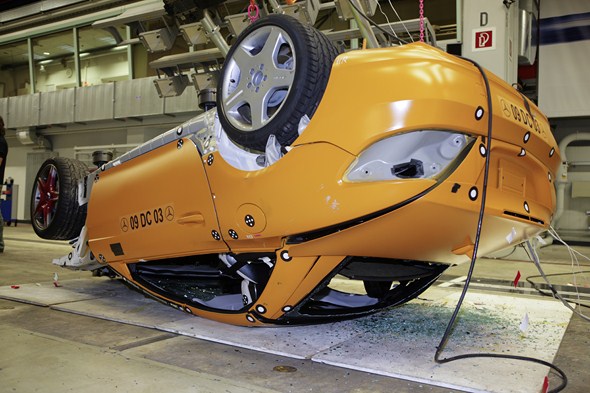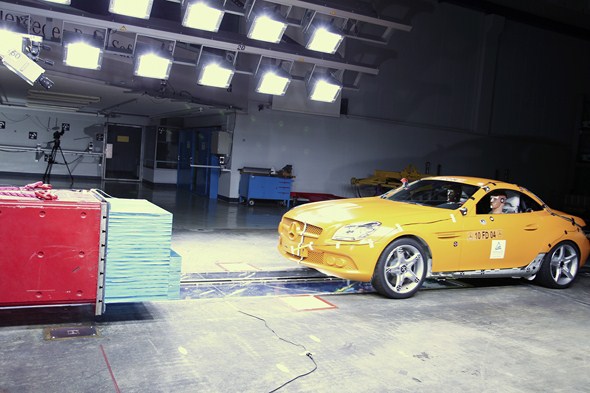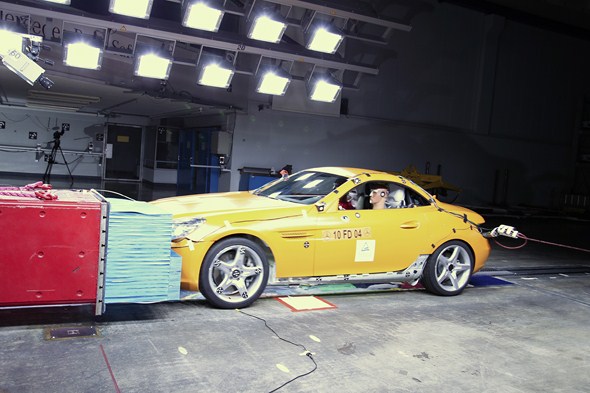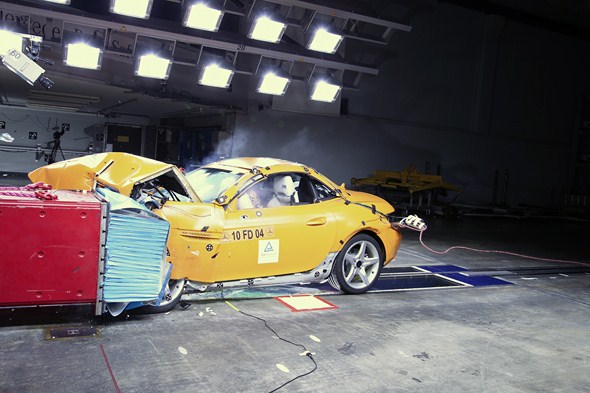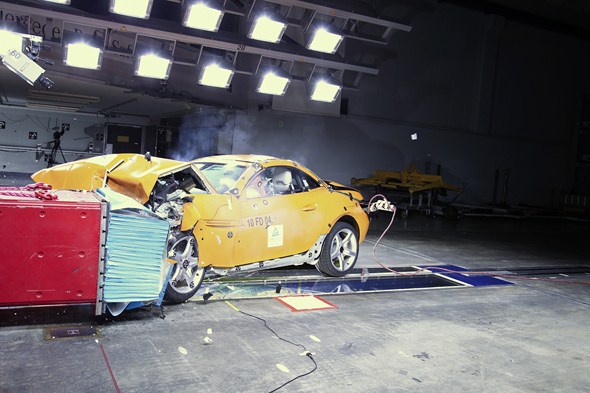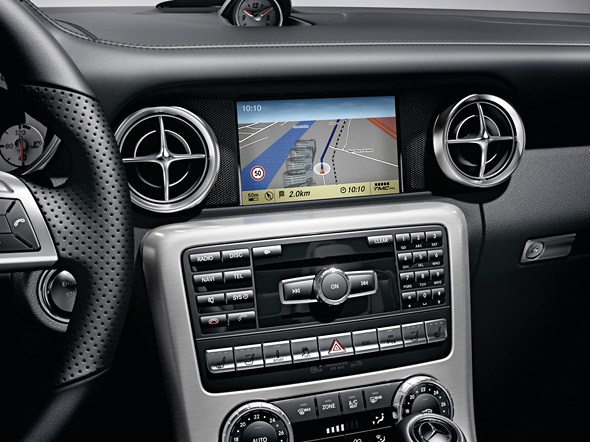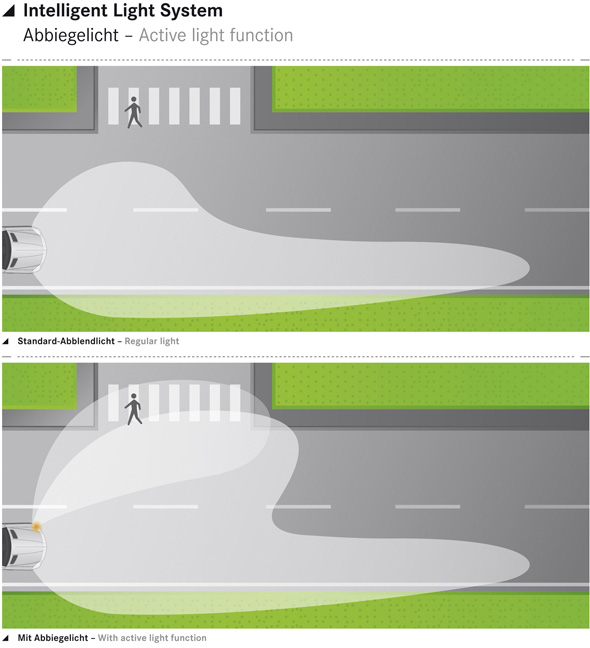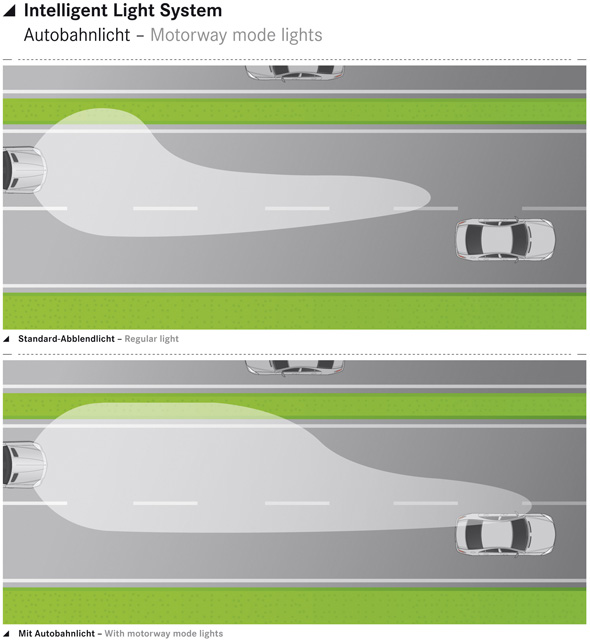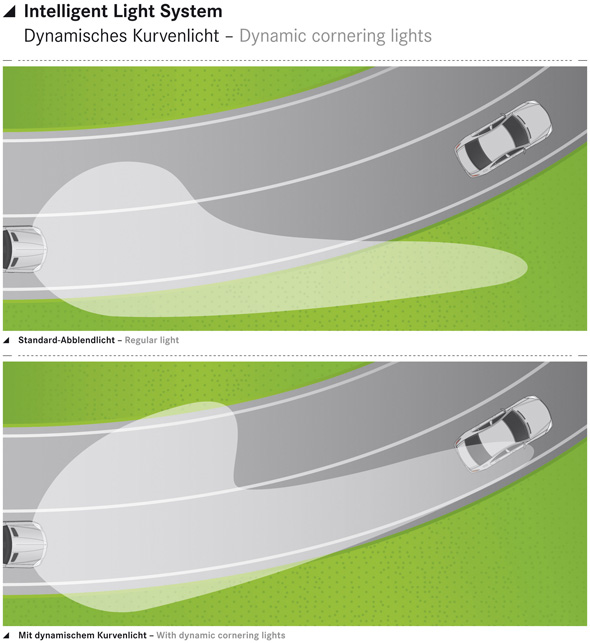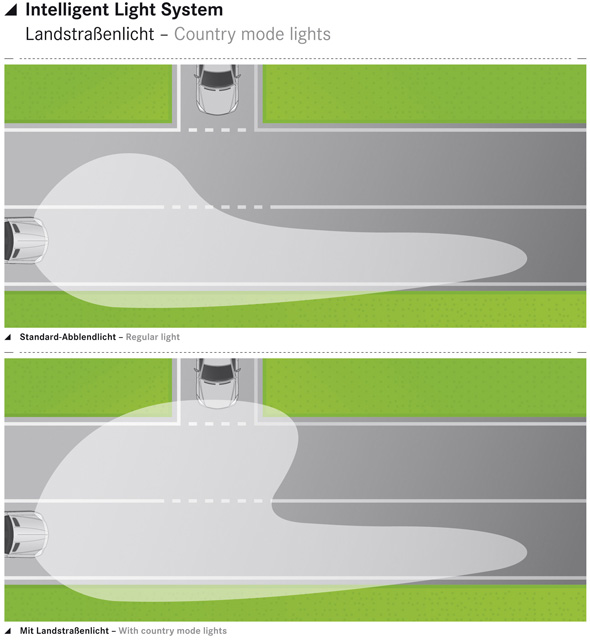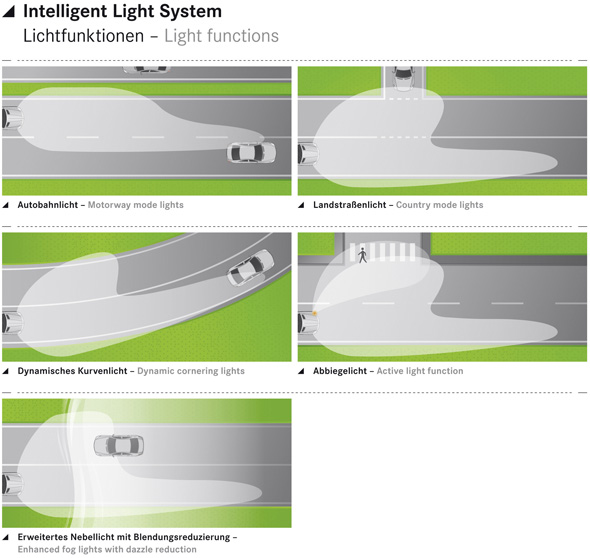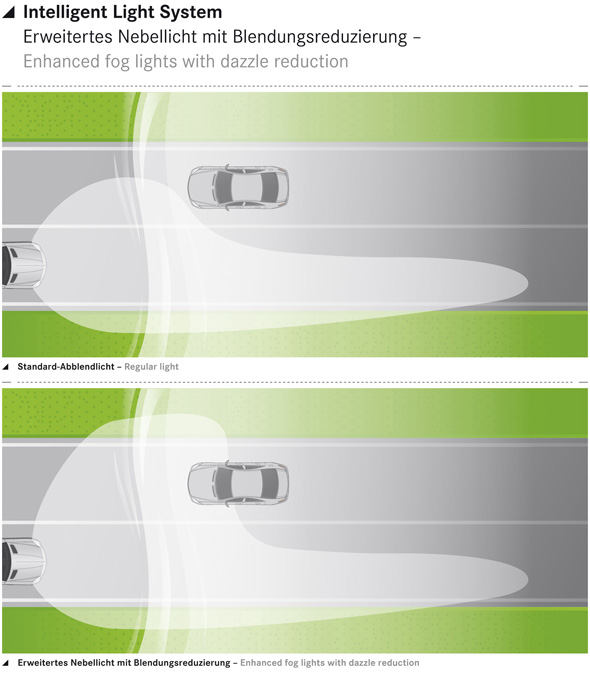The new Mercedes-Benz SLK Roadster


Passion, style and innovative technology – the new SLK sets standards
With the completely newly developed SLK, one of the most exciting and successful sports cars ever built is entering its third generation. The new roadster uncompromisingly takes driving pleasure and open-air enjoyment to a new level. It blends light-footed sportiness with stylish comfort, a striking sports-car design with total suitability for everyday use, top performance with exemplary ecology.
What’s more, the SLK is proud to present the world premiere of the panoramic vario-roof with MAGIC SKY CONTROL, which switches to light or dark at the touch of a button. Exemplary efficiency and sporty flair come courtesy of powerful new 4- and 6-cylinder engines featuring the standard-specification ECO start/stop function.
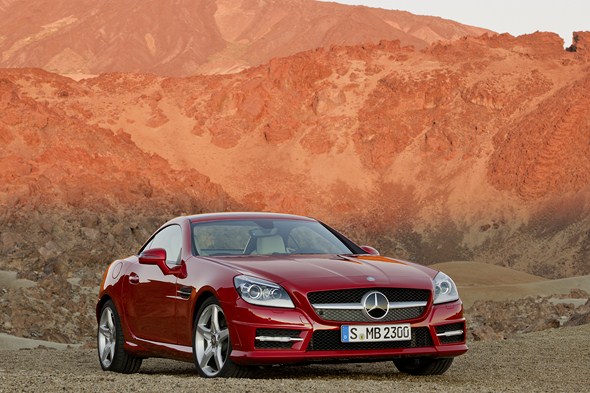
With their superb levels of performance, they are up to 25 percent more economical than their predecessors. With a unique set of safety equipment and a wealth of technical innovations, the SLK is once again the benchmark in its class.
“The new SLK embodies the role of the trend-setter like no other car”, says Dr Dieter Zetsche, Chairman of the Board of Management of Daimler AG and CEO of Mercedes-Benz Cars. “I am convinced that with its passionate design, its high-quality interior and its modesty at the filling station it will continue to provide an enormous amount of fun on the road in future, too, consolidating its status as a cult roadster.”
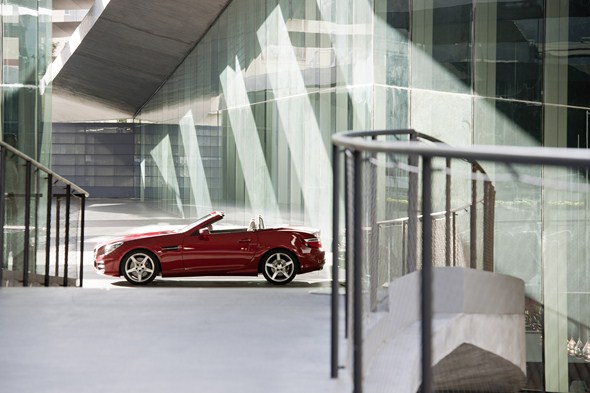
Innovations are part of the successful history of the Mercedes-Benz SLK:
- In 1996 the first generation caused a sensation with the vario-roof, which transformed the wide-open roadster into a coupé with a fixed roof at the touch of a button in just a few seconds;
- the second generation placed the warm AIRSCARF around the neck and shoulders of the occupants as needed, ensuring pleasurable open-top motoring even in cooler temperatures;
- now the third generation is presenting one of its unique highlights – the world premiere of the panoramic vario-roof with MAGIC SKY CONTROL. It can be quickly switched to light or dark at the touch of a button
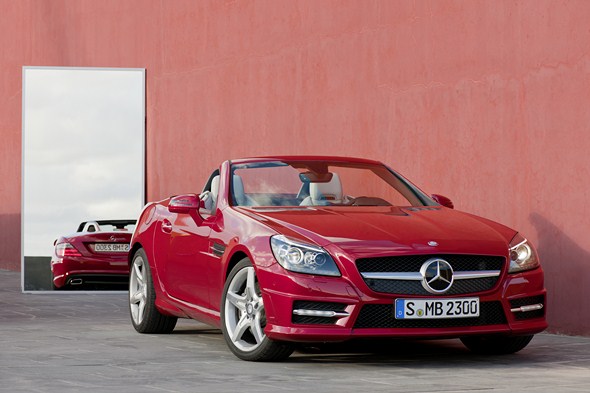
But the new Mercedes-Benz SLK offers more than merely individual highlights. It assumes a leading position in every discipline and offers fun at the wheel in every respect, with no half-hearted compromises. It impresses with characteristics which are generally deemed to be irreconcilable: it succeeds in uniting excellent comfort and high-quality equipment and appointments with a decidedly sporty flair, for instance.
At the same time the new roadster is the most economical and thus the most environmentally friendly in its class, also setting new safety standards. And all-weather driving enjoyment – open and closed, in leisure-time and everyday use – is firmly anchored in the SLK’s genes.
A distinctive design creates a sporty presence
The designers have tailor-made an outfit for the new SLK which emphasises its classic roadster proportions and puts them in the spotlight to thrilling effect. Behind the long bonnet is a compact passenger compartment positioned far back, and a short tail end. The SLK will tempt potential customers with the key attributes that characterise all the classic roadsters from Mercedes-Benz and that have also made many of them automotive icons.
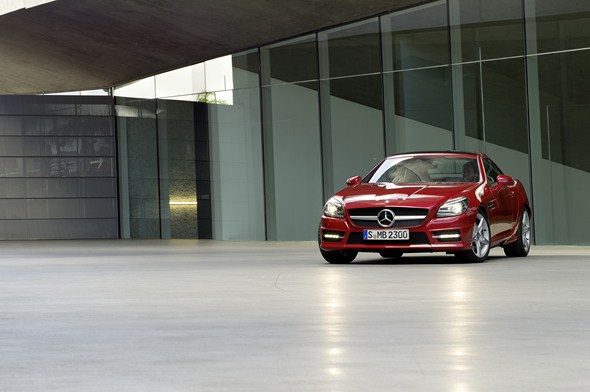
The first feature to catch the eye is an upright radiator grille that stands proud and confident in the wind. It facilitates the long and well-proportioned bonnet and with its rearward light-catching contours it already hints at the roadster’s dynamic qualities.
The wide radiator grille bears the Mercedes-Benz star in a prominent central position and displays a powerfully contoured fin, chromed at the front. The clearly defined headlamps complete the look for the new SLK’s face, which resembles that of the legendary 190 SL from the 1950s, which is regarded by many as being the original “SLK”. But it was certainly not just the past that the designers were focusing on; with the new SLK’s front end they also intentionally created a close visual link with the new Mercedes-Benz SLS AMG “gull-wing model” and the new CLS.
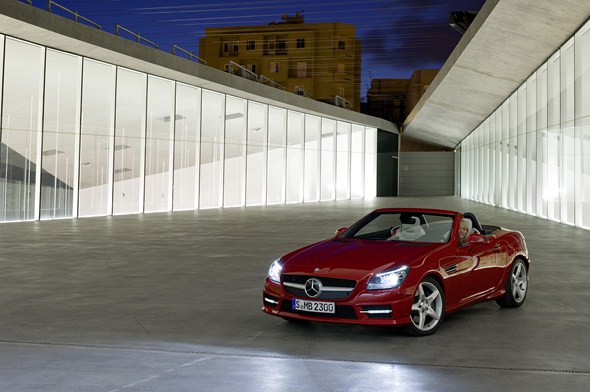
The amazing and measurable proof of the meticulously detailed work that has been carried out is that in spite of the more striking, steeper front and the larger frontal area, the Cd value has been cut to just 0.30 – a brilliant achievement (the preceding model’s Cd value was 0.32).
The closed, elegant shape of the side view with the classic roadster proportions quickens the pulse and is a visual promise of the sportiness and driving pleasure in store. Fine details show the care that has been taken by the Mercedes-Benz designers. For example, a fillet conceals the boot joint, so that it does not disturb the side aspect as with similar roof designs.
The ventilation grilles in the front wings with a chromed fin are reminiscent of the famous Mercedes-Benz roadsters of the 1950s. In the new SLK they form the perfect starting point for a feature line which flows to the muscular rear wing, using light and shadow to add style and elegance to the sides. Meanwhile the upper edge of the wide headlamps – which boast all-LED technology for the first time – also appears to flow into the feature line.
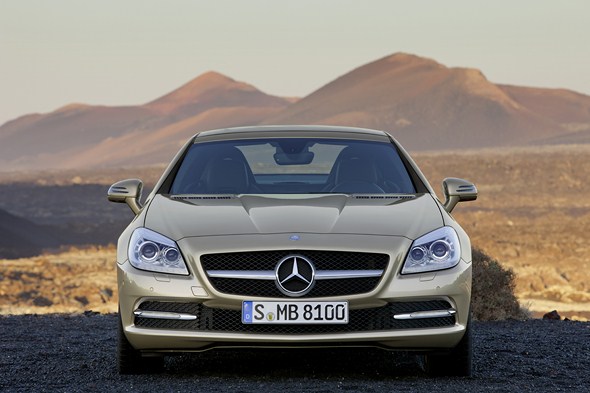
Interior with style and a feel-good atmosphere
With the most compact dimensions in its class, the new SLK has an interior whose generous size is exemplary. To achieve this, the designers have developed interior appointments which offer the driver and passenger a real feel-good ambience. The interior is characterised by sporty refinement, well-thought-out ergonomics and high-quality, authentic materials which have been processed with painstaking attention to detail and skilled craftsmanship.
Even in the base version the centre console and other trim parts gleam in brushed aluminium. Wood can be selected as an option in high-gloss dark brown walnut or high-gloss black ash. Four round, galvanised air outlets integrated in the dashboard emphasise that this model well and truly belongs to the Mercedes-Benz sports car family, their shape being derived from those in the SLS.
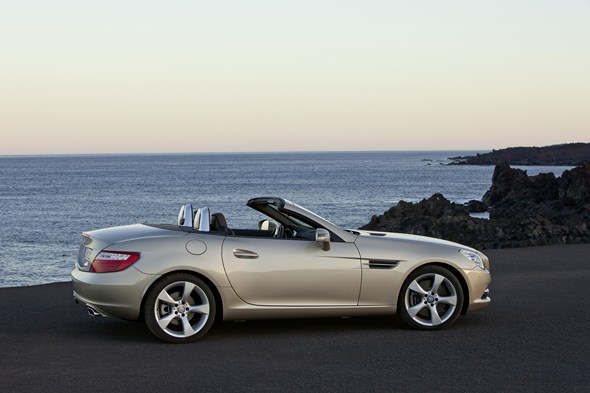
The SLK’s generous dial instruments are flanked by a display for the information generated by the online computer. The colour display for the communications and entertainment functions is housed in the centre of the dashboard, and can be easily read by both the driver and passenger. On the top of the dashboard, also in the centre, sits a fine analogue clock – an unusual detail which subtly underlines the roadster’s stylish character.
Other high-quality items of equipment include a multifunction sports steering wheel with a flattened lower section and a thick leather rim, plus optional sun-reflecting leather which noticeably reduces the degree to which the surfaces it covers heat up, impressive ambient lighting which for the first time has a red colour tone, and the innovative neck-level heating system AIRSCARF familiar from the preceding model.
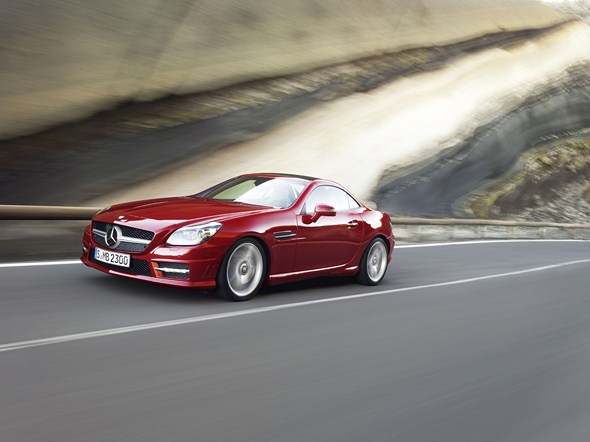
Unique feature: MAGIC SKY CONTROL
For the first time Mercedes-Benz is offering a choice of three variants of the lightweight-construction vario-roof for the new SLK. In just a few seconds this feature transforms the roadster into a coupé with a “fixed” roof at the touch of a button – and vice versa:
- The base version is a roof painted in the vehicle colour
- Alternatively there is the option of a panoramic vario-roof with tinted glass.
- The third variant is a world premiere – the panoramic vario-roof with MAGIC SKY CONTROL. This glass roof switches to light or dark as you wish at the press of a button. When light it is virtually transparent, offering an open-air experience even in cold weather. In its dark state the roof provides welcome shade and prevents the interior from heating up when the sun’s rays are very intense. In other words: a feel-good atmosphere at the touch of a button
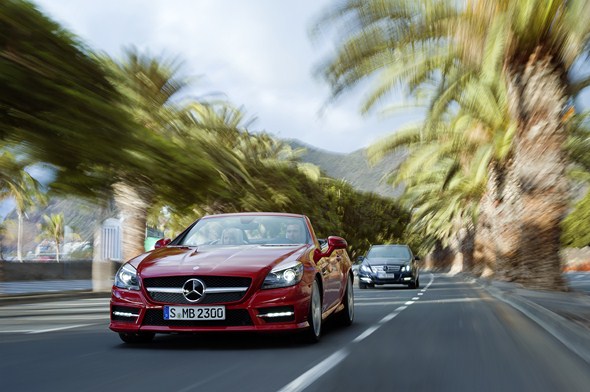
Innovative draught-stop system AIRGUIDE
A comfortable alternative to the conventional draught-stop is a new, pivoting draught-stop for the new SLK which has been invented by Mercedes-Benz aerodynamics engineers. It consists of pivoting, transparent perspex sections which are attached to the reverse of the roll-over bars.
The driver or passenger can pivot them to the centre of the vehicle in a flash, thus taming turbulent air flow. When the pivoting draught-stops are not required, they disappear almost invisibly behind the roll-over bars. There is no awkward disassembly and removal as with other draught-stops.
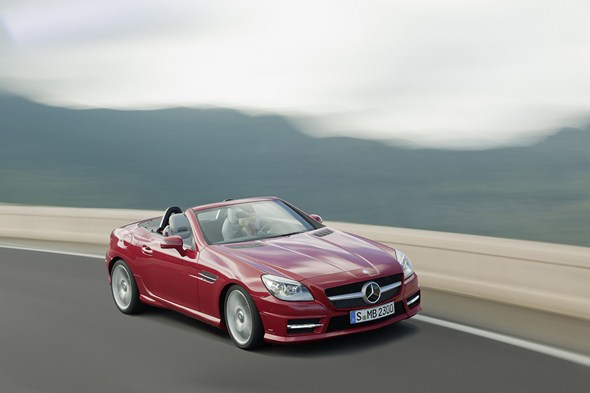
Spirit and efficiency
There will initially be three models of the SLK available at its market launch, all of them powered by new engines with direct injection. The four-cylinder engines in the SLK 200 BlueEFFICIENCY and SLK 250 BlueEFFICIENCY develop 135 kW (184 hp) and 150 kW (204 hp) respectively from a displacement of 1796 cubic centimetres. The SLK 200 BlueEFFICIENCY has the lowest CO2 emissions in its segment.
With the enhanced, optional seven-speed automatic transmission 7G-TRONIC PLUS it consumes just 6.1 litres of premium petrol (NEDC, combined) over 100 kilometres, corresponding to 142 g of CO2 per kilometre. This sporty model sprints from 0 to 100 km/h in 7.0 seconds, and achieves a top speed of 237 km/h (240 km/h with manual transmission).
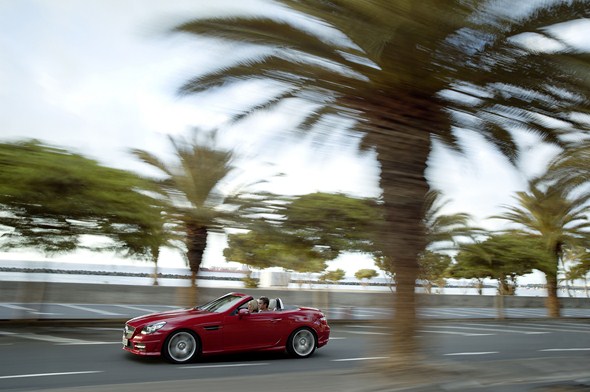
The SLK 250 BlueEFFICIENCY is initially equipped with the 7G-TRONIC PLUS automatic transmission (a six-speed manual transmission will become available at a later date) and consumes only 6.2 litres (NEDC, combined)
per 100 kilometres (144 g of CO2 per kilometre). From standstill it reaches 100 km/h in 6.6 seconds, and it has a top speed of 243 km/h.
The V6 engine in the SLK 350 BlueEFFICIENCY generates 225 kW (306 hp) from its 3498 cubic-centimetre displacement, using this power to accelerate from 0 to 100 km/h in 5.6 seconds (top speed 250 km/h). Its consumption is 7.1 litres (NEDC, combined) per 100 kilometres (167 g of CO2 per kilometre).
The V6 engine has been completely newly developed. Its most important hallmarks are 3rd-generation direct injection, piezo injectors and multi-spark ignition.
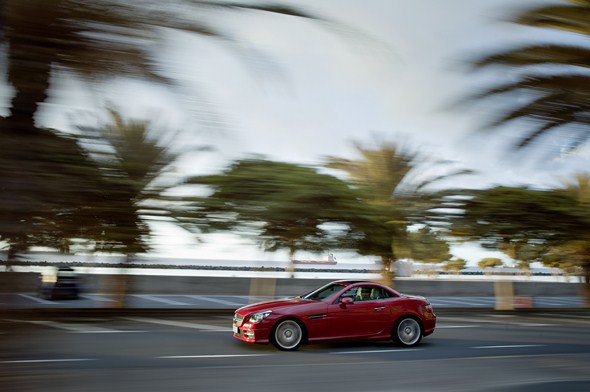
The exemplary efficiency, with fuel consumption reduced by up to a quarter compared to the preceding model, is also due to the ECO start/stop system which is fitted as part of the standard specification in all models.
Suspension for the closest connection to the road
There are also three suspension versions to choose from:
- A conventional steel suspension comes as standard
- A sports suspension with harder springs and dampers ensures a systematically sporty driving experience
- As an alternative a Dynamic Handling package is available. This includes an electronically controlled, fully automatic damping system. This means that the vehicle has excellent suspension comfort even on poor road surfaces, but still offers high driving dynamics
Also included in the Dynamic Handling package are a Direct-Steer system and the Torque Vectoring Brakes developed by Mercedes-Benz. The Direct-Steer system offers more handling and agility than the standard steering, whilst also reducing the amount of physical effort required when parking.
In critical conditions the Torque Vectoring Brakes produce a defined rotational movement of the vehicle about the vertical axis in fractions of seconds through selective brake actuation at the rear wheel on the inside of the bend. This results in the SLK stabilising without any compromises where dynamism is concerned, and it steers into the bend precisely and under full control.
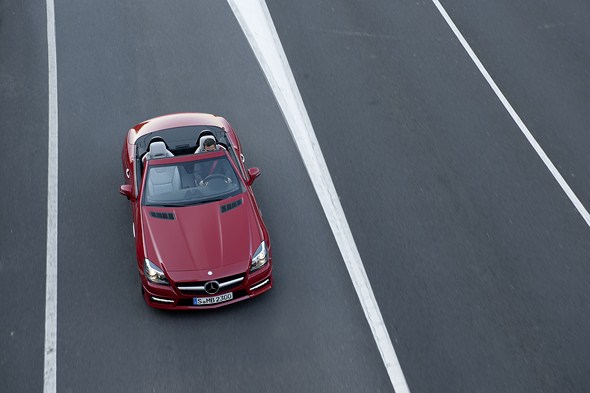
Ingenious material mix and high levels of safety
The new SLK’s bodyshell structure has been further refined, with the bonnet and wings now made of aluminium. The new Mercedes-Benz SLK also sets new benchmarks in terms of safety.
The third generation of the powerful trend-setter will make use of a whole host of the latest assistance systems to support the driver, including the drowsiness detection system ATTENTION ASSIST, developed by Mercedes-Benz and fitted as standard; the optional anticipatory occupant protection system PRE-SAFE®, which is unique in the world; and the PRE-SAFE® Brake, which can apply the brakes autonomously in the event of an impending rear-end collision.
This means that with the SLK too, Mercedes-Benz is consistently and significantly exceeding the requirements imposed by safety standards.
Further assistance systems are available on request:
- DISTRONIC PLUS: this proximity control system automatically maintains a set distance from the vehicle ahead, braking the roadster to a standstill if necessary and accelerating the SLK again.
- The Intelligent Light System provides five lighting functions (cornering light function, country mode, motorway mode, active light function and enhanced fog lamps), which are activated depending on the driving conditions
- Speed Limit Assist is able to detect speed limit signs using a camera on the inside of the windscreen, and indicate the detected speed limit in the instrument cluster or central display.
The market launch date for the SLK is 26 March 2011. Prices incl. 19% VAT:
SLK 200 BlueEFFICIENCY: 38,675 euros,
SLK 250 BlueEFFICIENCY: 44,256.10 euros,
SLK 350 BlueEFFICIENCY: 52,300.50 euros.
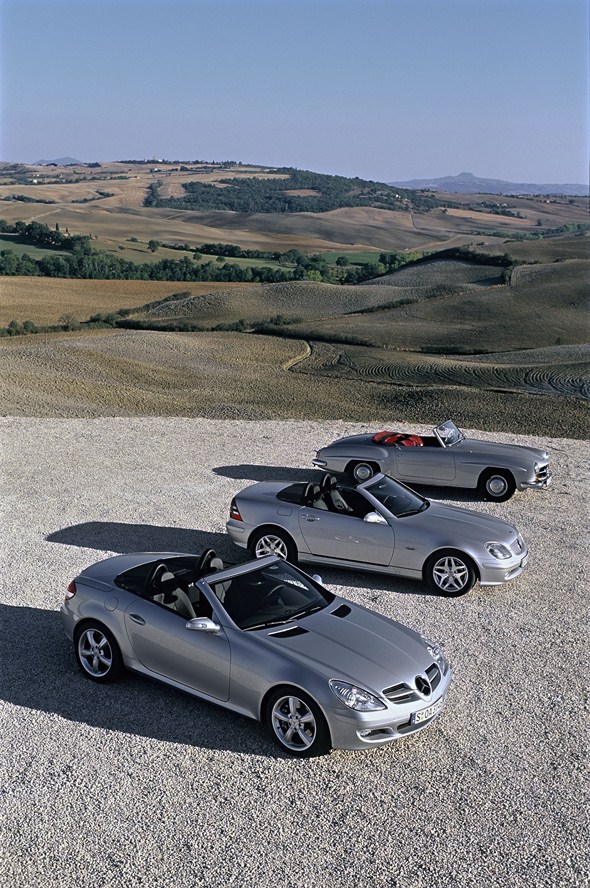
Model range
The SLK as a character: lively, passionate and refined
The new SLK raises driving pleasure to a new level, and will continue to set the trend in this segment. In its third edition the roadster excels with attributes that are normally considered to be irreconcilable: it combines lightfooted sportiness and exciting open-air enjoyment with stylish comfort, a striking sports car design with full day-to-day suitability and peak performance with exemplary environmental compatibility.
“The new SLK embodies the role of the trend-setter like no other car,” says Dr Dieter Zetsche, Chairman of the Board of Management of Daimler AG and CEO of Mercedes-Benz Cars. “I am convinced that with its passionate design, its high-quality interior and its modesty at the filling station, it will also continue to provide an enormous amount of fun on the road in future, consolidating its status as a cult roadster.”
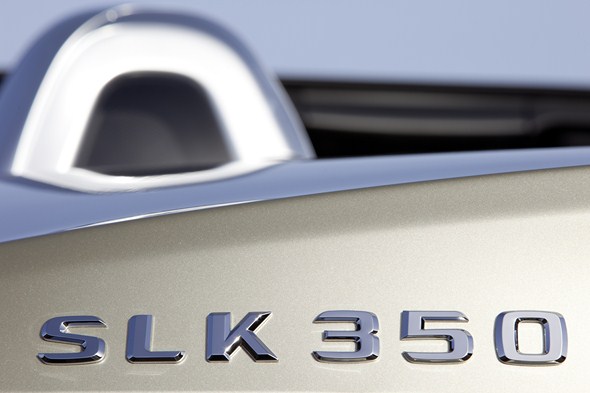
Innovations are part of the successful history of the Mercedes-Benz SLK:
- In 1996 the first generation caused a sensation with the vario-roof, which transformed the wide-open roadster into a coupé with a fixed roof at the touch of a button in just a few seconds;
- The second generation placed the warm AIRSCARF around the neck and shoulders of the occupants as needed, ensuring pleasurable open-top motoring even in cooler temperatures;
- For the very first time, the third generation offers a choice between three variants of the much-imitated vario-roof. One of these is celebrating its world premiere – the transparent panoramic vario-roof with MAGIC SKY CONTROL, which can be switched to light or dark. It therefore offers a choice of an open-top feeling even when the roof is closed, or provides shade in strong sunshine and prevents the interior from heating up. Alternatively the vario-roof is available in painted or glass versions.

The highlights of the new Mercedes-Benz SLK also include a striking and masculine sports car design, a sporty and refined interior with authentic,
high-grade materials and a choice of three suspension variants – a standard suspension, a sports suspension or a suspension with automatically adjustable damping.
Dr Thomas Weber, Member of the Board of Management responsible for Group Research and Head of Development, Mercedes-Benz Cars: “With the SLK we offer a wide range of technical alternatives to give customers a personal choice.
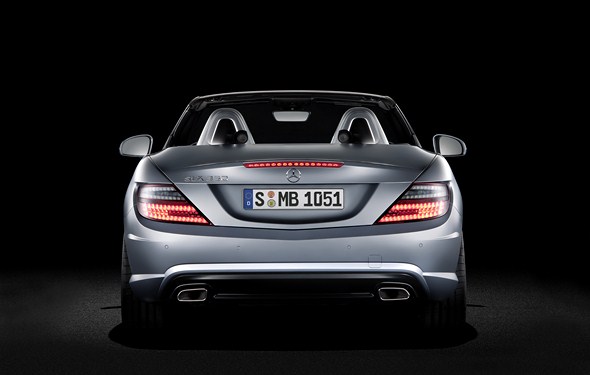
Among them are a number of unique innovations. Moreover, the SLK is a prime example of how impressive performance, stylish driving comfort and high ecological standards can go hand in hand. In the 125-year history of the automobile, we have never experienced such major leaps in efficiency. Lower fuel consumption and even more driving pleasure – a formula we certainly translate into reality in the SLK.”
Outstanding on all fronts
The best or nothing – this motto is at the heart of the Mercedes-Benz philosophy, and also the guiding theme for the new SLK. The original book of specifications already laid down that the design characteristics of the new roadster must not be one-sided, but must ensure top performance in all major disciplines.
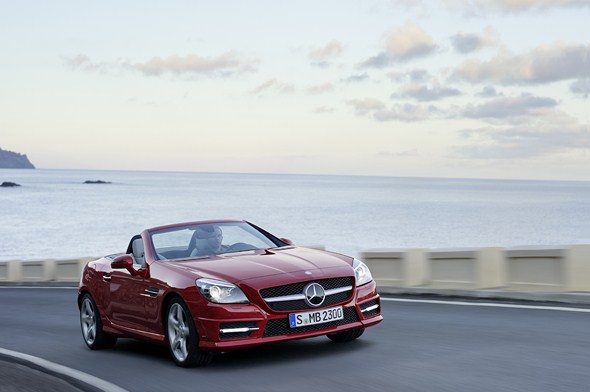
Mercedes-Benz engineers have rigorously translated this requirement into reality, and given the SLK attributes that guarantee the roadster a peak position in its segment in multiple respects. Among them are extremely compact dimensions combined with an extremely generous interior providing a feel-good atmosphere and numerous practical features. Naturally outstanding performance and sporty, agile handling are also major characteristics of the new SLK. Moreover, the new SLK is the most economical
- petrol model in its class, with three new, efficient and powerful direct-injection engines plus the ECO start/stop function,
- and also the safest roadster with its unrivalled range of safety features.
Dr Joachim Schmidt, Head of Sales and Marketing at Mercedes-Benz Cars: “Firmly embedded in the genes of the SLK is exhilarating driving pleasure in any weather conditions, open or closed, for recreation or day-to-day motoring.
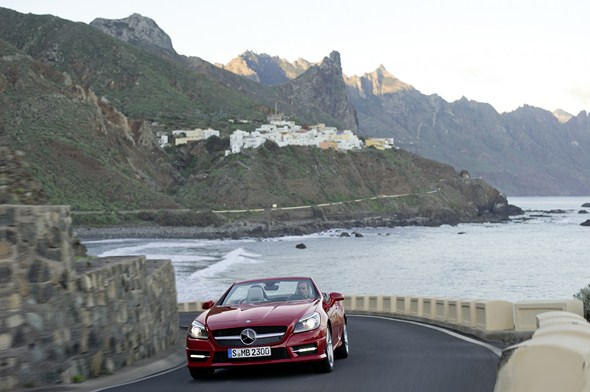
It combines its decidedly sporty character with outstanding comfort and high-grade appointments. The new SLK also sets new standards among the compact roadsters where fuel economy and environmental compatibility are concerned. A wealth of outstanding attributes and technical innovations will once again make it the benchmark in its class – and undoubtedly also a success for our brand. The SLK is a roadster with a character, and everyone will want it.”
A look back at the success achieved by the preceding models. Since the first generation was launched, the SLK has won the enthusiasm of more than half a million customers.
Even more features
The new SLK has a wealth of new features compared to its already well-equipped predecessor.
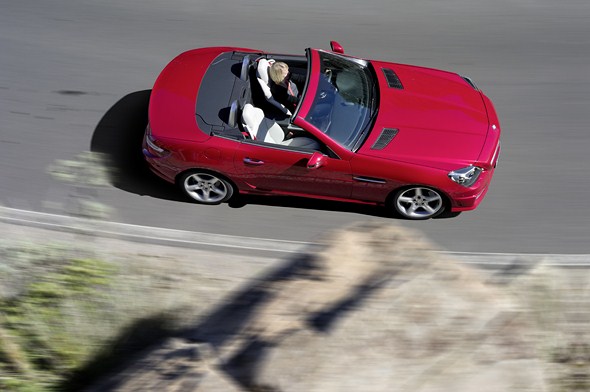
New standard equipment
- New-generation 4 and 6-cylinder engines with direct injection
- Adaptive brake lights
- ATTENTION ASSIST
- Audio 20 CD with 5.8-inch colour display, Bluetooth hands-free system, central head unit and USB connection
- NECK-PRO head restraints
- ECO start/stop function
- Electric parking brake (EPB)
- Headbags in the doors
- LED tail lights
- Air conditioning
- Boot with reversible floor and two elastic straps to secure luggage
- Optimised seven-speed 7G-TRONIC PLUS automatic transmission in the SLK 350 BlueEFFICIENCY
- Tyre pressure loss warning system
- Daytime running lamps
- Integrated aerials, also for GPS
- Brushed aluminium trim even for the basic version
New optional extras
- Ambient lighting with colour tone “SOLAR red”
- AMG Sports package
- Analogue clock on the dashboard
- Illuminated door sill panels
- COMAND Online with internet access, 7-inch colour display and central controller
- DAB tuner (Digital Audio Broadcast)
- DISTRONIC PLUS including PRE-SAFE® Brake
- Dynamic Handling package with adaptive damping, Torque Vectoring Brake and Direct-Steer system
- Entry-level navigation package “Becker®MAP PILOT”
- Speed Limit Assist
- Intelligent Light System with bi-xenon
- KEYLESS-GO
- Exclusive nappa leather
- PARKTRONIC with Parking Guidance
- PRE-SAFE®
- Sun-reflecting leather for cooler seats in strong sunshine
- Panoramic vario-roof
- Flex bottleholder
- Panoramic vario-roof with MAGIC SKY CONTROL (switchable transparency)
- Roll-over bars with anodised aluminium inserts
- AIRGUIDE draught-stop
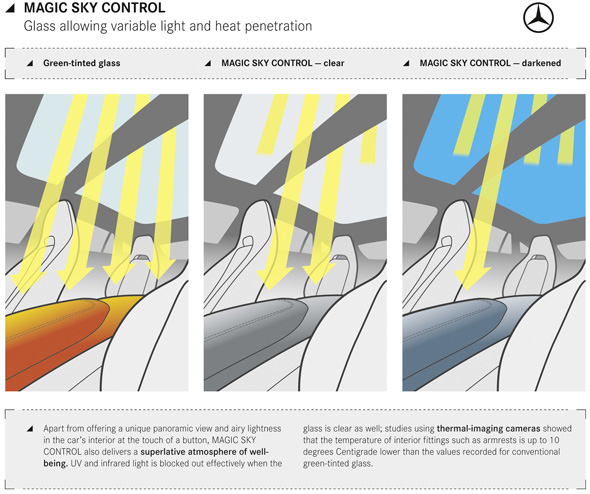
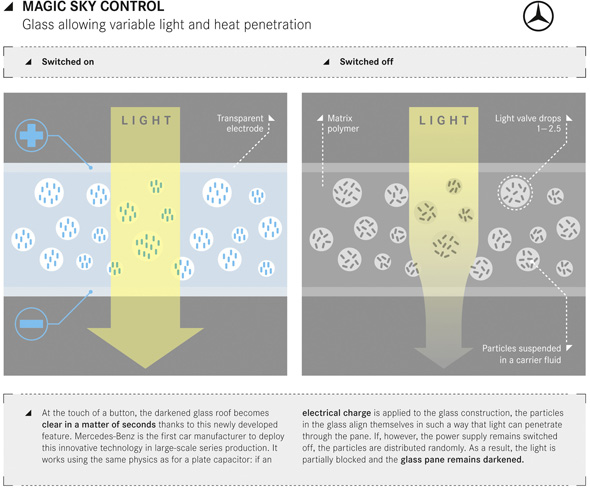
Design
Striking, sporty and stylish
The designers have tailor-made an outfit for the new SLK which emphasises its classic roadster proportions and puts them in the spotlight to thrilling effect. Behind the long bonnet is a compact passenger compartment positioned far back, and a short tail end. The SLK will tempt potential customers with the key attributes that characterise all the classic roadsters from Mercedes-Benz, and that have also made many of them automotive icons.
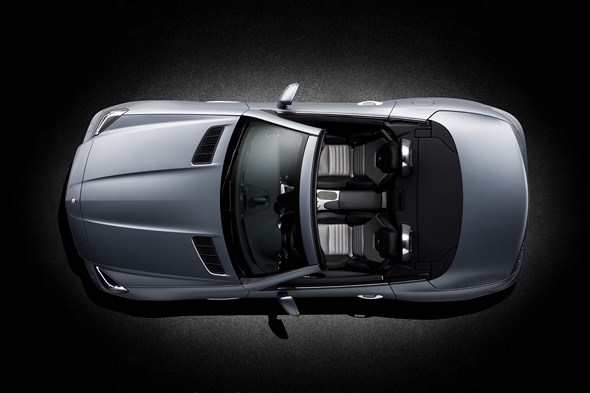
Professor Gorden Wagener, Head of Design at Mercedes-Benz Cars: “The SLK continues the illustrious roadster tradition of Mercedes-Benz, and excitingly takes it into the future. The design idiom accentuates its lively, sporty presence, and is also sculptural. It expresses personality and sensuality. The same applies to the interior. High-grade materials, lovingly crafted details and a very exclusive finish characterise the essentially very sporty atmosphere.”
Striking front end
The first feature to catch the eye is an upright radiator grille that stands proud and confident in the wind, bearing the new face of the Mercedes-Benz brand. It facilitates the long and well-proportioned bonnet and with its rearward light-catching contours it already hints at the roadster’s dynamic qualities. The bonnet ends with two air intake grilles in front of the windscreen, each embellished with three louvres.
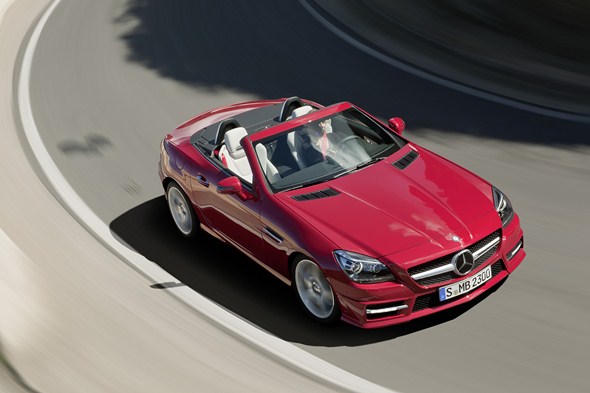
The wide radiator grille bears the Mercedes-Benz star in a prominent central position and displays a powerfully contoured fin, chromed at the front. The clearly defined headlamps complete the look for the new SLK’s face, and daytime running lamps with chrome surrounds (round lamps in the base version) in the bumper round off the front end.
The “face” of the new SLK is reminiscent of the legendary 190 SL from the 1950s, which is regarded by many as being the original “SLK”. But it was certainly not just the past that the designers were focusing on; with the new SLK’s front end they also intentionally created a close visual link with the new Mercedes-Benz SLS AMG “gull-wing model” and the new CLS.
The amazing and measurable proof of the meticulously detailed work that has been carried out is that in spite of the more striking, steeper front and the larger frontal area, the Cd value has been cut to just 0.30 (preceding model 0.32).
Dramatic lines
The classic, timeless lines of the side aspect with its typical roadster proportions embodies the utmost aesthetic appeal with a visual assurance of sportiness and fun. The vario-roof spans the interior like a drawn bow. When opened it disappears into the boot, creating the typical roadster silhouette.
From any angle and in any position it blends harmoniously into the overall design. A fillet conceals the boot joint, so that it does not disturb the side aspect as with similar roof designs. Neither are the lines disturbed by aerials in most equipment variants: in most cases they are integrated into the windscreen, rear window and parcel shelf.
The air outlet grilles with a chromed fin in the front wings are reminiscent of the famous Mercedes-Benz 300 SL Roadster from the 1950s. In the new SLK they form the elegant starting point for a feature line which extends right back to the muscular rear wings, and uses light and shadow to lend style and elegance to the side aspect.
This is emphasised by the stemmed exterior mirrors, which are positioned on the beltline where they allow a better forward view to the side. With their very narrow stems painted in the vehicle colour, these make a sporty and filigree impression. Their sophisticated aerodynamics also help to keep the side windows practically dirt-free, while ensuring a low level of wind noise.
Depending on the engine variant, the wheel arches house 16 or 17-inch light-alloy wheels, or 18-inch wheels with mixed-size tyres in conjunction with the sports suspension.
Muscular rear end
At the rear the eye is drawn to the integrated spoiler lip and wide tail light clusters. The roll-over bars feature double-skinned plastic claddings with a high-quality soft-look surface. As an optional extra these rear claddings can be of anodised aluminium.
For the first time, the tail lights with their pronounced horizontal emphasis are in all-LED technology. Their upper edge extends forward into the sides, harmoniously culminating in the feature line. A twin exhaust system with trapezoidal tailpipes rounds off the muscular impression created by the rear view.
High-grade materials and stylish sportiness
The new SLK is 31 millimetres longer and 33 millimetres wider than its predecessor. With the most compact dimensions in its class, the new SLK has an interior whose generous size is nonetheless exemplary. To achieve this, the designers have developed interior appointments which offer the driver and passenger outstanding perceived value, purist precision and a real feel-good ambience.
The interior in the base colour black is characterised by sporty refinement, well thought-out ergonomics and high-quality, authentic materials which have been processed with painstaking attention to detail and skilled craftsmanship. Even in the base version, the centre console and other trim parts gleam in brushed aluminium. Wood can be selected as an option in high-gloss dark brown walnut or high-gloss black ash.
Echoing the exterior design, the black dashboard emphasises the horizontal lines and therefore width of the vehicle. On request it is available in a two-tone colour scheme and with a leather lining. Four round, galvanised air vents similar in form to those in the SLS are recessed into the dashboard, underlining the car’s membership of the Mercedes-Benz sports car family and at the same time deliberately creating associations with the dynamism of jet aviation.
Two large dial instruments – a speedometer and a rev counter – flank a display for the information generated by the online computer. The display menus can be conveniently accessed by the driver using the control buttons on the steering wheel, without taking his eyes off the road. The colour display for the communication and entertainment functions is housed in the centre of the dashboard, and can be easily read by both the driver and passenger. A comfortably shaped controller on the centre armrest ensures safe and easy operation.
On the top of the dashboard, also in the centre, sits a fine analogue clock (optional), subtly underlining the roadster’s stylish character.
An easily handled (diameter 375 millimetres) multifunction sports steering wheel with a flattened bottom section and a thick leather rim makes the high quality and sporty character of the new SLK a constant tactile experience. Metal trim on the spokes enhance the impression of both sportiness and refinement.
Shift paddles to perform upshifts and downshifts in the automatic transmission are available as an option. The interior can be enhanced even further with a wood/leather steering wheel.
The sweeping lines of the upper dashboard section are continued into the door panels. The door centre panel is colour-coordinated with the interior. The door openers and seat adjustment switches are trimmed in aluminium or wood.
Sporty yet comfortable seats
The sporty, ergonomic seats with adjustable, crash-responsive NECK-PRO head restraints integrated into the backrests have high side bolsters for optimum lateral support and a high level of comfort on long journeys. Maximum operating convenience and seating comfort is ensured by optional electric seat adjustment with a memory function and 4-way lumbar support.
In the base version the new SLK is equipped with black fabric seats. There is also a choice of:
- embossed leather in black, sahara beige or crystal grey,
- nappa leather in black, bengal red or moccha/nut brown, or
- Exclusive nappa leather – in this case the upper dashboard section and the doors are lined with black nappa leather.
All leather and nappa leather seats are upholstered with leather which noticeably reduces heat build-up. The leather has a special coating which reflects the sun’s rays. Comparative measurements have shown that this leather reduces the temperature of the seats by more than ten degrees Celsius – a significant improvement in comfort when the car has been parked in the sun.
As in the previous model, the neck-level heating system AIRSCARF is available as an optional extra for the new SLK. This creates a flow of warm air around the neck and shoulder areas of the occupants from a vent in the front of each head restraint.
Magical lighting
An ambient lighting system available as an option for the first time creates an impressive effect in the interior of the new SLK. It consists of discreet optical fibres and spots in SOLAR RED, which produce an extremely pleasant yet sporty lighting effect in the door panels, around the door pulls and on both sides of the centre console. This mood-enhancing ambient lighting is activated when the doors are opened (“welcome home” effect), and its intensity can be individually varied by a dimmer.
The central lighting unit in the overhead control panel has two interior lights and a centre console spotlight.
Clever stowage compartment concept
For a two-seater roadster, the new SLK has an exemplary variety of stowage facilities in the interests of versatility and day-to-day utility. The basis for
this well conceived interior concept is a large glove compartment with a remarkable capacity of 6.4 litres. Useful features such as holders for a pen, credit cards and coins are integrated into the glove compartment lid.
There are three stowage compartments in the centre console – below the air conditioning controls (this can be replaced by an ashtray on request), next to the controller in front of the armrest (roller-top compartment, optionally a drinks holder) and under the armrest with a 12 V socket, USB interface and AUX connection (optionally a media interface for integration of e.g. an iPod
and mobile phone connection). A net attached to the tunnel in the passenger footwell can be fitted with a flexible bottle-holder which can securely accommodate even 1.5-litre bottles.
Excellent climate
The new SLK is equipped with air conditioning as standard. The automatic climate control system THERMOTRONIC with separately adjustable interior temperatures for the driver and passenger is available on request.
An example of the detailed refinements: a windscreen demisting sensor in the stem of the rear-view mirror registers the glass temperature and interior humidity level of the new SLK. In dry weather, when no cooling is required but A/C is operating, the control system powers the compressor down but activates it as soon as it registers that the windscreen is misting up. This has two advantages:
- The A/C function can remain active all the time, but the demand-controlled system saves energy.
As the air conditioning only demoisturises and cools as much air as is required to maintain the interior temperature, the air is never too dry and this benefits the physical comfort of the occupants.
Vario-roof and body
Innovative technology with a unique roof concept
Driving a roadster is a wonderful emotional experience. Gliding through the landscape and its many sounds and smells at the wheel of an agile sports car, with the top down and the sun shining, awakens intensive and joyous feelings. In a Mercedes-Benz SLK, even rainy weather does little to mar this pleasure. Ever since the launch of the first SLK in 1996, this has been ensured by a vario-roof which converts the roadster into a coupé with a fixed roof at the touch of a button, and in just a few seconds. Since then, Mercedes-Benz engineers have constantly refined the vario-roof even further and maintained the SLK’s pioneering role in this technology.
Unique item of equipment: MAGIC SKY CONTROL
For the first time, Mercedes-Benz is offering a choice between three variants of the lightweight vario-roof for the new SLK:
- The base version is a roof painted in the vehicle colour
- Alternatively there is the option of a panoramic vario-roof with tinted polycarbonate.
- The third variant is a world premiere – the panoramic vario-roof with MAGIC SKY CONTROL. This glass roof switches to light or dark as required at the press of a button. When light it is virtually transparent, offering an open-air experience even in cold weather. In its dark state the roof provides welcome shade and prevents the interior from heating up when the sun’s rays are very intense. In other words:
a feel-good atmosphere at the touch of a button
The operating principle is based on the physics of a plate condenser: if the glass structure is subjected to an electrical voltage, particles in the structure position themselves so that light is able to pass through the glass. If the voltage remains switched off, however, the particles position themselves randomly.
This partially blocks the light, and the glass remains dark. The control unit and converter are integrated into the front section of the roof, and the switch is in the overhead control console.
In addition to the unique panoramic effect and transparency at the touch of a button, MAGIC SKY CONTROL also provides a top-class feel-good atmosphere. UV and infrared light are also effectively blocked in transparent mode, while insulation increases even more significantly and noticeably in darkened mode, thereby helping to keep the temperature on interior parts such as armrests cooler by up to 10 degrees Celsius compared with conventional tinted glass.
Measurements using a device called a star pyranometer in Death Valley, one of the world’s hottest places, impressively demonstrated the effect. This device measures the intensity of exposure to sunlight. With an open roof, the thermal load from the sun in the heat of Death Valley reached 1000 to 1100 W per square metre.
With the transparent glass roof it dropped to 200 W, and when the roof was switched to darkened mode with MAGIC SKY CONTROL, it dropped to 40 to 50 W – one 20th of the original value and less than a 60 watt bulb.
Since the innovative glass also shields against the sun’s rays far more effectively than conventional thermal insulation glass or sunblinds, the occupants of the new SLK also enjoy the highest level of climatic comfort.
When driving with the roof open would be unpleasant owing to intense heat, the driver and front passenger are able to relax under the MAGIC SKY CONTROL roof – an important contribution to onboard comfort and the driver-fitness safety typical of a Mercedes. Even when the vehicle is at a standstill the interior does not overheat, since the roof is switched to darkened mode when powered off.
But MAGIC SKY CONTROL not only benefits passengers. Some of the strain is also taken off the air-conditioning system, thereby saving on CO2 emissions.
In addition, the frame of the three roof variants is now of magnesium. This makes each roof around six kilograms lighter than in the previous model, giving the car a lower centre of gravity.
The engineers have also refined the operating mechanism for the roof and boot lid. It now takes less than 20 seconds to open or close the roof completely. The improved mechanism mainly benefits the boot capacity.
Boot fully suitable for everyday use
The luggage capacity with the vario-roof closed is 335 litres (in conjunction with TIREFIT). This is enough to accommodate two crates of soft drinks and two crates of beer, or four of either, without difficulty. A golf bag or a large suitcase are also no problem.
When the roof is opened, the capacity is reduced by 110 to 225 litres. This includes 51 litres of luggage box capacity under a reversible floor (the box is omitted if a collapsible spare wheel is chosen instead of TIREFIT). In any case there is sufficient space for two large sports bags, for example with tennis equipment.
The luggage box or collapsible spare wheel is accessible if the variably usable reversible floor is removed. Depending on the application, it provides a level surface or a recess for carrying e.g. high drinks crates. The draught-stop or an umbrella can be secured with elastic straps on either side of the reversible floor.
To prevent luggage items from colliding with the roof components while these are being deposited in the boot, there is a luggage cover in the boot which can be pivoted longitudinally. The vario-roof can only be opened if this cover is pivoted to the rear, and when the roof is closed the cover can be easily pivoted forward by hand. This facilitates loading and unloading, and makes the full boot capacity available.
Bodyshell structure with aluminium components
The bodyshell structure already proved highly successful in the preceding model, and was weight-optimised still further for the new SLK. Accordingly the bonnet and front wings are of aluminium for the first time, as are the dashboard cross-members and the rear end. The rear bulkhead module of fibre-reinforced plastic is a new feature. The torsional rigidity of this optimised lightweight steel construction was improved even further compared to the already very rigid preceding series. Thanks to the intelligent use of lightweight construction methods, the bodyshell weight was reduced by around 13 kilograms.
The doors are a completely new development, with reinforcement at the beltline and at the lower edge. A section of high-strength steel ensures good side impact protection. The well-proven A-pillars with welded-in oval tubes of hot-formed ultra-high-strength steel and a robust nodular connection to the side members remain unchanged.
To keep the cost of minor damage caused by a frontal impact at speeds up to 15 km/h reasonable, the front side members have a prescribed cutting point for a sectional repair, and their shape causes them to bend ahead of this area in the event of a collision.
Exemplary aerodynamics
Despite the more striking, steeper front and the just under three percent larger frontal area compared to the previous model, the Cd value for the new SLK has been cut to just 0.30 – a very good figure for a roadster (the preceding model had a Cd value of 0.32). This improvement has enabled CO2 emissions to be reduced by roughly one to two grams per kilometre. Once again this shows that the engineers at Mercedes-Benz have made good use of many possibilities to enable SLK owners to enjoy the fun factor in the new roadster with an easy conscience – thanks to its high environmental compatibility.
The aerodynamic data for the new SLK-Class
| New SLK-Class* | Previous model* | |
| Drag coefficient Cd | 0.30 | 0.32 |
| Frontal area (A) sq. m. | 1.98 | 1.93 |
| Wind resistance Cd x A sq. m. | 0.59 | 0.62 |
*with vario-roof closed
In addition to familiar features such as a spoiler lip on the upper edge of the boot lid, wheel spoilers in front of the front and rear wheels, and a full engine compartment and underbody cladding concept, the excellent drag coefficient is especially due to:
- A radiator shutter for demand-related control of the cooling airflow,
- highly aerodynamic tyres,
- newly designed exterior mirrors and
- painstaking modifications to the A-pillar cladding.
The A-pillar cladding is a good example of meticulous development work. It took more than one year to develop a plastic cover that would combine high design requirements with exemplary functioning perfection. The result is a pillar cover with a fine front edge and a drainage channel on the upper surface. This ensures a very close airflow and therefore a significant reduction in air resistance, as well as very good results in terms of draught protection, aeroacoustics and reduced soiling of the exterior mirrors and side windows.
Innovative draught-stop system AIRGUIDE
To reduce draughts when driving with the roof open, the SLK can be fitted with a draught-stop. This consists of a net with a fixed frame which is installed between the head restraints. When not in use it can be stowed in the boot, where it occupies little space.
A comfortable alternative to the conventional draught-stop is a new pivoting draught-stop for the new SLK which has been invented by Mercedes-Benz aerodynamics engineers. It consists of pivoting transparent plastic layers which are attached to the reverse of the roll-over bars. This is the world’s first draught protection system that enables different comfort levels to be selected for two occupants, as the driver and passenger can individually pivot the units to the centre of the vehicle in a flash, thus taming turbulent air flow from the rear. Advantage: no installation or removal effort is required.
Modern headlamp technology and LED daytime running lamps
In the base version the new Mercedes-Benz SLK is equipped with single-tube H7 headlamps. These are combined with round daytime running lamps with chromed surrounds in the bumper. On request, horizontally arranged, elongated LED daytime running lamps with four LEDs can be fitted in a chrome clasp to give the SLK an even more striking front. If the vehicle is equipped with the Intelligent Light System or the AMG Sports package, these LED daytime running lamps are included. A manually operated and electrically activated headlight beam control system is standard equipment with halogen headlamps. The Intelligent Light System has automatic headlight beam control.
Alternatively the new SLK can be equipped with the Intelligent Light System (ILS) developed by Mercedes-Benz.The Intelligent Light System provides five lighting functions (cornering light function, country mode, motorway mode, active light function and enhanced fog lamps), which are activated depending on the driving conditions. In this case the main headlamps are twin-tub units, and for the first time the indicators and position lights are in LED technology.
The ILS headlamps automatically feature dynamic headlamp range control. This automatically adjusts the angle of the light beam to changes in the car’s attitude – for example pitching movements when braking and accelerating – and when the attitude changes if a load is carried.
The wide tail lights of the new SLK are for the first time in full-LED technology. This not only ensures an unmistakable night design, but also enables LEDs to shine with different intensities in specific areas of the tail light cluster, depending on their lighting function. LED technology has other advantages: compared to conventional bulbs they light up around 150 milliseconds faster, and also have a considerably longer operating life – a safety aspect that should not be underestimated.
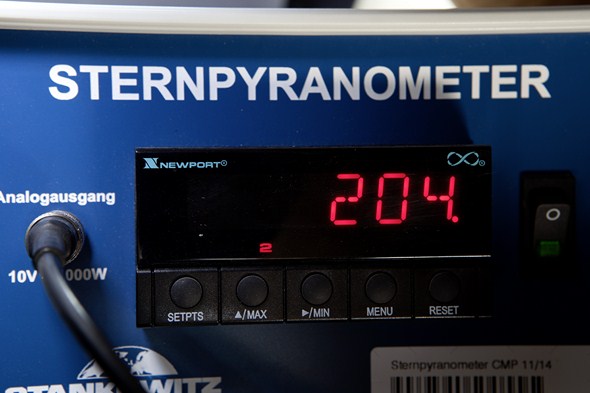
Drive system
Sporty spirit and ecological efficiency
The engines for the new SLK excel with a considerably lower fuel consumption combined with a comparable or higher output than those in the preceding series, as well as sporty and emotional appeal. There will initially be three models of the SLK available at its market launch, all of them powered by new engines with direct injection.
The four-cylinder engines in the SLK 200 BlueEFFICIENCY and SLK 250 BlueEFFICIENCY develop 135 kW (184 hp) and 150 kW (204 hp) respectively from a displacement of 1796 cubic centimetres. The SLK 200 BlueEFFICIENCY has the lowest CO2 emissions in its segment. With the enhanced, optional seven-speed automatic transmission 7G-TRONIC PLUS it consumes just 6.1 litres of premium petrol (NEDC, combined) over 100 kilometres, corresponding to 142 g of CO2 per kilometre.
This sporty model sprints from 0 to 100 km/h in 7.0 seconds, and achieves a top speed of 237 km/h (240 km/h with manual transmission).
The SLK 250 BlueEFFICIENCY is equipped with an automatic transmission as standard, and consumes only 6.2 litres (NEDC, combined) per 100 kilometres (144 g of CO2 per kilometre). From standstill it reaches 100 km/h in
6.6 seconds, and has a top speed of 243 km/h.
The V6 engine in the SLK 350 BlueEFFICIENCY generates 225 kW (306 hp) from its 3498 cubic-centimetre displacement, using this power to accelerate from 0 to 100 km/h in 5.6 seconds (top speed 250 km/h). Its consumption is 7.1 litres (NEDC, combined) per 100 kilometres (167 g of CO2 per kilometre). The V6 engine has been completely newly developed. Its most important hallmarks are 3rd-generation direct injection, piezo injectors and multi-spark ignition.
Key engine data for the new SLK-Class:
| SLK 200 BlueEFFICIENCY | SLK 250 BlueEFFICIENCY | SLK 350 BlueEFFICIENCY | |
| Cylinders | 4/in-line | 4/in-line | V6 |
| Displacement | 1796 cc | 1796 cc | 3498 cc |
| Output, kW/hp | 135/184 at 5250 rpm | 150/204 at 5500 rpm | 225/306 at 6500 rpm |
| Max. torque at | 270 Nm at 1800-4600 rpm | 310 Nm at 2000-4300 rpm | 370 Nm at 3500-5250 rpm |
| Fuel consumption (NEDC, combined), l/100 km | 6.1 – 6.5( 6.4 – 6.86)* | 6.2 – 6.6 | 7.1 |
| CO2 g/km | 142-151(149-158)* | 144 – 153 | 167 |
| 0 – 100 km/h | 7.0 (7.3)* | 6.6 | 5.6 |
| Top speed | 237 (240)* | 243 | 250** |
* with six-speed manual transmission
** governed
Thanks to the great efficiency, it was possible to reduce the tank capacity of the new SLK-Class to 60 litres (a 70-litre tank is available as an optional extra). Nonetheless the operating range is more than 900 kilometres, or more than 800 kilometres for the SLK 350 BlueEFFICIENCY.
From autumn 2011 the new SLK will also be available with a powerful diesel engine.
Four-cylinder with a bite
The four-cylinder engines for the new SLK follow the so-called downsizing principle, with the reduced cubic capacity compensated by homogeneous direct injection and turbocharging. This leads to advantages such as lower weight and reduced in-engine friction. A smaller engine also moves the operating range of the characteristic map towards more favourable values, with consequent fuel consumption benefits.
The direct injection system of the four-cylinder engines has an injection pressure of up to 140 bar. In the interests of improved efficiency, this allows the compression ratio to be increased versus a conventional duct injection system. The fuel evaporating directly in the combustion chamber also lowers the temperature in the combustion chamber, reducing the engine’s tendency
to knock. The engine is homogeneously charged.
The same turbine rotors are used to generate charge pressure in both output variants of the four-cylinder engine. The single-flow turbocharging of the
four-cylinder units operates more efficiently than a mechanical charger,
as no engine output needs to be devoted to the charger.
Other characteristics of the four-cylinder engines include a four-valve concept with forged intake and exhaust camshafts, as well as camshaft adjustment on the vane-cell principle. This enables the valve timing to be rapidly and variably adjusted. The result is high torque even at low engine speeds, and a higher specific output.
The crankcase and cylinder head are cast from aluminium alloy. The crankshaft is likewise cast, and has eight counterweights. To compensate the secondary masses inherent to a four-cylinder in-line engine, two Lanchester balancer shafts rotate within the crankcase at twice the crankshaft speed.
An electronically controlled thermostat ensures logic-controlled engine warm-up (no coolant flows through the cylinder head when the engine is cold), and therefore intelligent thermal management. The warm-up phase is shortened as a result.
Sporty engine note
A sporty engine note produced by a new sound generator lends an acoustic backdrop to the 4-cylinder variants of the new SLK. This generator is located immediately in front of the throttle flap, and “enriches” the engine note with elements of the intake noise. It filters out certain frequencies from the intake noise and conducts them into the vehicle interior via a pipe connection – an ingeniously simple and very convincing solution for a sporty and emotionally appealing engine sound.
New V6 engine with innovative technology
The six-cylinder engine is a member of the new V6 family for which
Mercedes-Benz has developed the currently most efficient form of direct injection. Known as BlueDIRECT, this innovation establishes the V-engines from Mercedes-Benz as worldwide benchmarks and makes a further reduction in fuel consumption by 20 percent possible by in-engine measures alone.
The V-angle of the new V6 engine is only 60 degrees. This enables the balancer shaft for primary vibrations to be omitted. As a result, the driver notices an excellent level of comfort.
The crankcase, pistons and cylinder heads of the V6 are of aluminium. The crankshaft, connecting rods and valves are of special forged steel.
The technology package in the new engine generation includes a number of new developments that are unique in this combination:
- In combination with multi-spark ignition, a further developed,
third-generation spray-guided direct fuel injection system with piezo-electric injectors offers further possibilities for fuel savings by means of a new, stratified combustion process with a considerably extended characteristic map and fuel-efficient lean-burn technology.
- Power consumption by ancillary units has been reduced. These include an optimised water pump with 2nd-generation thermal management, a demand-controlled oil pump, a volume-controlled high-pressure fuel pump and an intelligent generator management system.
Lightweight construction techniques and detailed improvements have also reduced in-engine friction considerably compared to the previous engine.
Third-generation direct-injection system
Spray-guided direct petrol injection, which Mercedes-Benz was the first car manufacturer to introduce in series production, has been developed further as a third generation. The system pressure is up to 200 bar, the pressure being variably optimised according to the engine’s characteristic map. Completely newly developed piezo-electric injectors allow up to five injections per intake stroke for the best possible mixture formation.
The crystalline structure of the piezo-ceramic changes in microseconds under an electric voltage, and with a precision of just a few thousandths of a millimetre. The central component of a piezo-electric injector is the piezo-stack, which directly controls the metering needle. With a response time of just 0.1 milliseconds, the fuel injection can be very sensitively and precisely adjusted to the current load and engine speed, with a beneficial effect on emissions, fuel consumption and combustion noise.
In the V6 unit, the multiple injections even in tiny quantities made possible with piezo-electric injection technology were used by Mercedes-Benz engineers to control a wider, usable characteristic map with the efficient lean-burn process, and to provide the conditions for further functions.
As the first new operating mode, Mercedes-Benz engineers have developed “Homogeneous stratified combustion” (HOS). As the name implies, HOS is a combination of homogeneous lean-burn and classic stratified combustion. With the engine unthrottled, the first injection is sprayed into the intake stroke, forming a homogeneous basic mixture. Actual “stratified” injection takes place during the compression stroke before ignition, and is a single or double injection depending on the characteristic map.
Another new operating mode is known as “Homogeneous Split” (HSP). In this homogeneous combustion process, more than 95 percent of the fuel is singly
or multiply injected, followed a very small “ignition” injection to stabilise combustion. This is used when combustion conditions are difficult.
The characteristic map of the new Mercedes-Benz V6 engine is therefore basically divided into up to four areas:
- idling range à homogeneous
- low partial load up to 4 bar and 3800 rpm à stratified
- medium partial load 4 to 8 bar and up to 4000 rpm à HOS
- high load and entire engine speed range à homogeneous or HSP
Multi-spark ignition for optimal efficiency
The third-generation direct injection system also features rapid multi-spark ignition (MSI). Following the first spark discharge and a brief combustion period, the coil is rapidly recharged and a further spark is discharged. The
MSI system enables up to four sparks to be discharged in rapid succession within one millisecond, creating a plasma with a larger spatial expansion than conventional ignition. Controlling this rapid multi-spark ignition enables both the time lapse before the next spark and the combustion duration for the relevant operating point to be optimally adjusted. This provides scope for optimising the centre of combustion and improving residual gas compatibility, especially during stratified charge operation. Fuel consumption can be reduced by roughly two percent in this way.
Fuel savings of up to 4 percent are possible alone by the use of piezo-electric injection technology in combination with multi-spark ignition, depending on the driving cycle.
Cylinder head with new camshaft adjuster
Mercedes-Benz engineers modified the variable, hydraulic vane-type camshaft adjusters for the intake and exhaust sides using the basic architecture of the preceding engine. These now have a larger adjustment range of 40 degrees with reference to the crankshaft. They were also able to improve the functionality, achieving a 35 percent greater adjustment speed and adjustability at an oil pressure as low as 0.4 bar. Despite the better performance, this new development excels with significantly smaller dimensions and low weight. For this reason the installation space on the longitudinal and vertical axes of the engine was able to be reduced by around 15 millimetres.
Two-stage chain drive for low noise
The extreme compactness of the camshaft adjusters was achieved by the new, two-stage chain drive. This drives two secondary chains – one per cylinder bank – via a primary chain and an intermediate gear. All three chains can be individually adjusted via a chain tensioner. This results in low tensioning forces and low chain dynamics, ensuring consistent timing and outstanding acoustic properties, with friction reduced even further. In short, the new chain drive is compact and ensures low-noise operation.
Exhaust system for stringent emission standards
The exhaust systems for the SLK were developed to meet the exhaust emission standards Euro 5 and ULEV, as well as noise emission standards. The exhaust system for the 4-cylinder petrol engine consists of a firewall catalytic converter, a centre muffler and two rear mufflers.
The emission control system for the V6 petrol engine has a firewall catalytic converter for the right and left cylinder banks. The exhaust gases then flow into storage-type NOx catalytic converters. These are followed by a twin-pipe centre muffler and rear mufflers designed as reflection/absorption mufflers on the left and right. The system is rounded off by two exhaust tailpipes on the right and left.
ECO start/stop function with intelligent direct-start
The exemplary efficiency, with fuel consumption reduced by up to a quarter compared to the preceding model, is also due to the ECO start/stop system which is fitted as part of the standard specification in all models – now also with the 7G-TRONIC PLUS automatic transmission.
Realising an auto-stop and auto-start function at the high comfort level of a Mercedes-Benz requires complex control logic, a number of new or modified components and a heavy-duty starter motor. Operating principle:
- As a general principle, the engine is switched off every time the vehicle comes to a standstill (auto-stop function)
- With an automatic transmission, there is always an automatic restart when one of the following conditions is met – the driver operates the accelerator, the transmission is shifted to R, the transmission is shifted from P, the driver releases the brake pedal and Hold is not activated.
- With a manual transmission, there is always an automatic restart when one of the following conditions is met – the driver operates the accelerator, the driver operates the clutch.
Restarting the engine (auto-start function) takes place almost imperceptibly; and moving off without any noticeable time lag compared to a stationary vehicle with its engine running. This is because the new start/stop system uses starter-supported direct-start. This means that when the engine stops, a new crankshaft sensor identifies the rotational position of the crankshaft and enables the engine control unit to identify the cylinder in which the piston is ideally positioned for restarting. The fuel is injected into this cylinder first, thereby speeding up the starting process. The engine is then briefly turned over by the starter, immediately making reliable injection, ignition and combustion possible. On restarting, a reduced fuel quantity can be injected directly into the first cylinder to ensure a fast starting procedure, e.g. at traffic lights.
An additional electric transmission oil pump supplies the clutches of the automatic transmission with oil pressure prior to starting, so as to enable a swift resumption of the journey after direct starting of the combustion engine via the ECO start/stop function. The starter motor (starter) has also undergone thorough modification: it is now designed to cope with eight times as many starting procedures, ensuring that it will last a car’s lifetime in continuous urban driving involving frequent auto-starting. In addition, the on-board electrical system is supported by a second battery.
Automatic transmission with fuel economy benefits
The SLK 200 BlueEFFICIENCY is equipped with the familiar 6-speed manual transmission, which excels with a short, sporty shift travel. The improved
7G-TRONIC PLUS seven-speed automatic transmission is available for this model as an option, and is standard equipment for the other two engine variants (a 6-speed manual transmission will be available as an alternative for the SLK 250 BlueEFFICIENCY at a later date). It has undergone extensive further development with the aim of achieving an engine connection with further decreased torque converter slip, a significant reduction in internal losses and therefore optimised efficiency. Mercedes-Benz developers subdued eccentricities and vibrations in the transmission by incorporating a new torsion damper, for example. This is designed as a twin-turbine damper, and also makes comfortable vehicle operation possible at low engine speeds.
In ECO mode this has enabled engine speeds to be reduced as a result, with a considerable contribution to fuel economy (up to seven percent). It also allows an even faster response to accelerator commands. A new hydraulic circuit and optimised torque converter mapping also contribute to better start-off performance. As a further fuel economy measure, a new transmission fluid with a lower viscosity and a long service life for the same cooling performance is used. This means that replacement of the transmission fluid is only necessary every 125,000 kilometres.
The optimised electrohydraulic control unit of the transmission and new reduced-friction materials in various parts of the transmission in combination with optimised software result in improved shifting comfort. Owing to an optional, additional demand-controlled ATF pump, 7G-TRONIC also can feature a start/stop function for the first time. This pump ensures readiness to move off when the internal oil pump is not operating.
Adjustable radiator shutter not only saves fuel
For the first time in a sports car, and depending on the engine variant and country version, Mercedes-Benz uses an adjustable radiator shutter in the SLK. This enables the airflow through the engine’s cooling module and engine compartment to be variably controlled. A circular, louvred shutter arranged parallel to the fan improves the aerodynamics, which in turn lowers fuel consumption. The engine also reaches its normal operating temperature more rapidly, heating comfort is improved and engine noise is suppressed even more.
Diesel variant and an AMG version to follow
In the fourth quarter of 2011 a powerful four-cylinder diesel engine will be available for the new SLK. In 2012 the SLK 55 AMG will follow with a new V8.
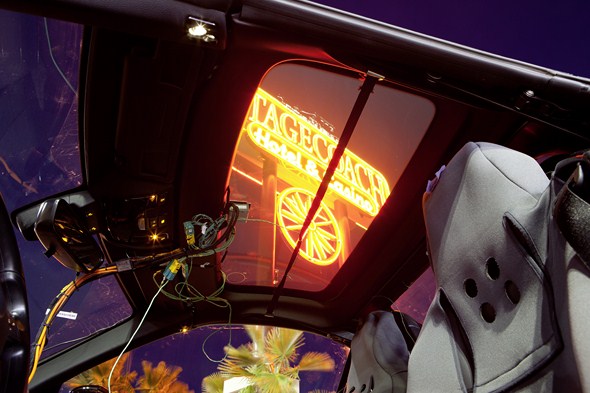
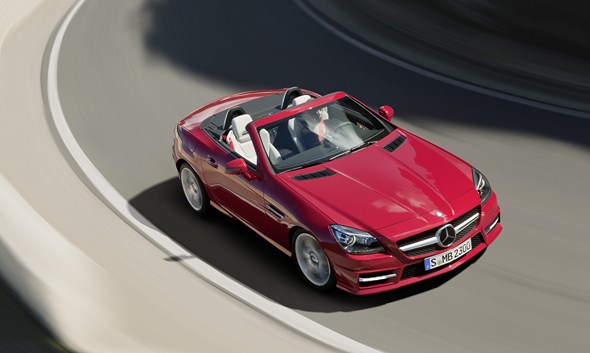
Suspension
The closest connection to the road
It is the suspension that establishes contact with the road, and ride comfort and agile handling depend on it. The new Mercedes-Benz SLK offers a choice
of three versions:
- A conventional steel suspension comes as standard
- A lowered sports suspension with harder springs and dampers ensures a systematically sporty driving experience
- As an alternative a Dynamic Handling package is available. Its merits include a suspension with continuous adjustable damping. It has an electronically controlled fully automatic damping system, so the vehicle rolls away gently even on poor road surfaces, but still offers high driving dynamics
Also included in the Dynamic Handling package are a Direct-Steer system and the Torque Vectoring Brake developed by Mercedes-Benz.
Wheel location is the same for all three suspension variants: a 3-link suspension locates the wheels at the front, while at the rear this is done
by a multi-link independent suspension which has already impressively demonstrated its unrivalled wheel location qualities in the preceding model.
In the new SLK this has forged aluminium hub carriers, in order to reduce unsprung masses even further in the interests of even better roadholding.
All models in the new SLK-Class also have a torsion bar stabiliser, which is attached directly to the body.
The standard suspension is a conventional steel suspension with wheel-locating front axle spring struts, a torsion bar, twin-tube shock absorbers at
the front and single-tube shock absorbers with rear axle springs at the rear.
The optional sports suspension has a stiffer damper setup, shorter suspension springs and torsion bar stabilisers with a larger cross-section. The suspension is also lowered by ten millimetres. The roll control system has been reinforced to achieve even smaller roll angles when cornering at speed.
Suspension with automatic, continuously adjustable damping
The suspension with automatic, continuously adjustable damping, which is included in the Dynamic Handling package, sets new standards. It allows sporty and agile handling for maximum driving pleasure on winding country roads, but also cossets the occupants with excellent road roar and tyre vibration characteristics and a high level of stability on poorer road surfaces. An electronic system automatically and continuously ensures that the dampers are always set to suit the driving situation. The response time is normally only around 10 milliseconds.
Setting the basic characteristics of the suspension is still left to the driver, however, using a switch that enables him to choose comfortable or sporty damping characteristics. At the touch of a button he therefore has a suspension setup available which offers the same comfort as the standard suspension. If he chooses the sport setting, he is opting for a driving experience with a very high level of dynamic response.
Like the sports suspension, the suspension with variable damping is equipped with torsion bars with a larger cross-section, and the suspension is lowered by ten millimetres.
Brakes for sporty driving enjoyment
The well-proven, dual-circuit hydraulic braking system and the distribution
of the two circuits to the front and rear axles has been adopted from the preceding model. All variants are equipped with single-piston floating calliper brakes all-round. In the entry-level SLK 200 BlueEFFICIENCY the calliper housings are of aluminium, while the more powerful engine variants use housings of composite aluminium at the front and aluminium at the rear.
The brake covers at the front axle were optimised in the wind tunnel for even more efficient cooling of the brakes and wheel bearings, and to protect the brake discs from road spray.
Brake disc dimensions
| SLK 200 BlueEFFICIENCY | SLK 250 BlueEFFICIENCY | SLK 350 BlueEFFICIENCY | |
| front, internally ventilateddia./thickness (mm) | 295/28 | 322/32 | 344/32 |
| reardia./thickness (mm) | 300/10 | 300/10 | 300/10 |
Torque Vectoring Brake: ESP® helps with the steering
The Dynamic Handling package includes the Torque Vectoring Brake system. This ensures an additional safety margin at the physical limits, makes the SLK even more agile and therefore enhances the sportiness of the roadster. The system achieves this with targeted, one-sided braking intervention by the Electronic Stability Program ESP® at the inside rear wheel when cornering. If ESP® detects a tendency to understeer, the Torque Vectoring Brake generates a defined turning or yawing moment around the vehicle’s vertical axis within fractions of a second. Thanks to the different torque distribution that results, the SLK turns into the bend under precise control without any loss of handling dynamics. The advantage of this solution over complex mechanical components such as an active steering rear axle, additional multi-disc clutches or an active differential: the Torque Vectoring Brake can be implemented without an increase in vehicle weight and therefore no disadvantages in terms of fuel consumption.
Electric parking brake
As a new feature in Mercedes-Benz roadsters, the electrically operated parking brake in the new SLK helps in the design of a generous interior. Its switch is located in the dashboard, under the rotary light switch. Pressing this engages the electric parking brake, and pulling releases it. In models with an automatic transmission the brake is released automatically as soon as the engine is running, the transmission is in the D or R position, the driver has a fastened seat belt and the accelerator is operated.
Direct and comfortable – the steering of the SLK
Like the preceding model, the base version of the new SLK has a constant-ratio steering system, however the ratio is more direct. This means that instead of 2.8, only 2.6 turns of the steering wheel are necessary from lock to lock.
The Dynamic Handling package includes a hydraulically assisted Direct-Steer system. This increases the agility and controllability of the SLK compared to the standard steering, and improves steering comfort when parking as less effort is required. It combines these attributes with predictable and safe steering characteristics at high speeds. As a result, the agile cult-roadster corners even more willingly and precisely, allows relaxed cruising on motorways and makes for even more exhilarating driving pleasure.
The new Direct-Steer system was developed from the familiar speed-sensitive steering that Mercedes-Benz offers for many of its models. In this case the steering effort depends on the vehicle speed – the effort required increases with the speed. In practice this means more steering comfort during parking manoeuvres and more safety at higher speeds, for example on motorways, where a greater steering effort ensures safe straight-line stability.
The new Direct-Steer system retains these positive attributes of speed-sensitive steering and adds a variable steering ratio that changes according to the steering angle. The ratio is indirect when the steering is centred, which ensures good straight-line stability and therefore a high level of safety. In contrast to other variable steering systems, the ratio of the Direct-Steer system increases rapidly after a steering angle of 5 degrees, becoming extremely direct from a steering angle of just 100 degrees. Only relatively small steering movements are then needed to make course corrections.
This has the following effect in practice: even at urban driving speeds, the driver needs to perform less pronounced steering movements, making changes in direction possible more rapidly and with less effort. The effect of the Direct-Steer system is even more impressive on winding country roads, where only small steering movements are sufficient to steer the vehicle. Even on tighter bends, the driver’s hands hardly need to change their grip on the steering wheel. Rapid sequences of bends can be mastered almost intuitively safely and precisely, and with enormous enjoyment. This all adds up to considerably more agile handling.
The increase in driving dynamics is also aided by an increased yaw rate (steering response) at low to medium speeds, as this augments the effect of the steering movement. At high speeds this increase in yaw rate is small, which means that the car responds safely and predictably to steering movements.
Despite its remarkable effect, the key component of the Direct-Steer system is simply a steering rack. Its secret lies in the teeth cut into it. In the mid-area these are slightly wave-shaped, with varying flank profiles. To both sides the teeth are spaced at varying distances apart. The change in steering ratio is therefore produced by purely mechanical means. With this solution, Mercedes engineers have been able to dispense with the complex actuators and sensor systems used by other variable steering systems. The advantages include very low susceptibility to faults and low weight. Moreover, the system always responds predictably and in the same way, while other variable steering systems sometimes require rapid adaptation by the driver in rapidly changing situations.
ECO steering servo pump lowers fuel consumption
Driving straight ahead in the new SLK also means saving fuel. This is ensured by an ECO steering servo pump as standard in all SLK models. Its centrepiece is an electrically actuated proportional solenoid valve which variably opens a bypass aperture at the pressure connection to feed the steering gear with just the right amount of fluid. As the steering has a lower energy requirement when driving straight ahead, the throughflow pressure in the steering system can be minimised. Less energy is therefore consumed.
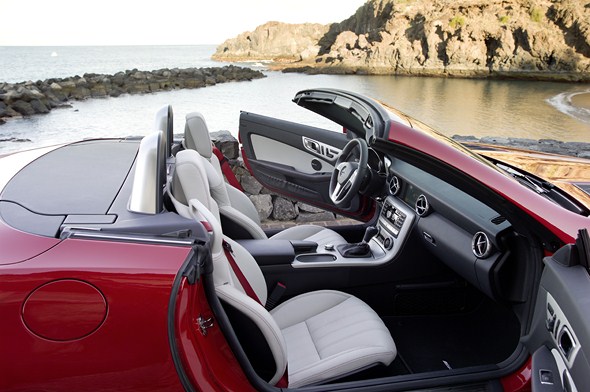
Safety
Top technology for the greatest possible safety
The new Mercedes-Benz SLK sets new safety standards in the roadster segment. The best or nothing – the safety experts at Mercedes-Benz have long adopted this motto, coined by Gottlieb Daimler, as their guiding principle. Far from contenting themselves with achieving rating targets, they work intensively on attaining a level of safety which far exceeds the standards stipulated by the world’s legislators. The most important measure of their work is not the laboratory or crash test facility, but actual, real-life accidents. They call the results of their work Real Life Safety, a concept which is based on research into thousands of accidents. Using this irrefutable evidence, the Mercedes-Benz engineers have developed or initiated most of the assistance systems which today effectively support drivers and have been adopted by many of the company’s competitors.
ATTENTION ASSIST and ADAPTIVE BRAKE as standard
The new SLK also features a unique combination of driver assistance systems which help to avoid accidents. These include the drowsiness detection system ATTENTION ASSIST, for example. Thanks to this system, the roadster develops a precise feeling for the level of attentiveness of the driver and can provide an early warning of overtiredness.
Also making up part of the standard equipment specification is the ADAPTIVE BRAKE. It comprises ABS, the acceleration skid control system ASR and also active yaw control (GMR). In addition, it features the following functions:
- it supports the driver when moving off uphill, by preventing the vehicle from unintentionally rolling back;
- it also keeps the vehicle stationary without having to keep the brakes applied continuously – for example when waiting at traffic lights
(HOLD function); - as soon as the driver abruptly steps off the accelerator, it brings the brake pads into light contact with the brake discs as a precautionary measure, so that the necessary braking pressure can be attained quicker in the possible event of emergency braking;
- in wet conditions it applies light brake contact, without the driver even noticing, to dry the brake discs.
The ADAPTIVE BRAKE works in conjunction with the equally adaptive brake light. In emergency braking situations, it warns vehicles behind with flashing brake lights.
Emergency braking on detecting an acute risk of a front-end collision
Available as optional extras are the DISTRONIC PLUS proximity control as well as the PRE-SAFE® Brake, already tried and tested in other Mercedes-Benz models. Both systems work in conjunction and can initiate emergency braking automatically on detecting an acute risk of an accident.
In normal driving conditions, the radar-based DISTRONIC PLUS proximity control adjusts the distance to the vehicle in front automatically. If necessary, it can apply the brakes, even bringing the SLK Roadster to a stop, and accelerate it again. This takes some of the strain off the driver, particularly in bumper-to-bumper driving conditions. If the distance starts to narrow too quickly, the system gives the driver visual and audible warnings, thereby prompting the driver to take action, at which point he is also supported by Brake Assist PLUS (BAS PLUS).
If the systems detect the acute danger of a rear-end collision and the driver fails to respond to visual and acoustic warnings, the electronics activate the PRE-SAFE® Brake in preparation for autonomous braking. This happens in two stages:
- Around 1.6 seconds before the calculated impact point the system decelerates the car with around 40 percent (approx. four m/s²) of
the maximum braking power, gives the driver an additional, haptic warning of the impending impact and as a precaution activates the reversible PRE-SAFE® occupant protection system. - If the driver still fails to react, the PRE-SAFE® Brake activates the maximum braking power around 0.6 seconds before the now unavoidable collision – this emergency braking can greatly reduce the severity of the impact. The system therefore acts like an “electronic crumple zone”, offering the car occupants even greater protection.
The PRE-SAFE® Brake is active at speeds of between 30 and 200 km/h when moving vehicles are detected in front of the car. The system also reacts if
the car approaches a stationary queue of traffic, providing its speed is below
70 km/h.
Safety and comfort
Those wishing to do so can extend the range of assistance systems in the new SLK even further with the addition of features enhancing both safety and comfort:
- The Intelligent Light System provides five lighting functions (cornering light function, country mode, motorway mode, active light function and enhanced fog lamps), which are activated depending on the driving conditions
- Speed Limit Assist is able to detect speed limit signs using a camera on the inside of the windscreen, and indicate the detected speed limit in the instrument cluster or central display.
- The optional PARKTRONIC incl. Parking Guidance supports the driver when parking. Its ultrasonic sensors measure the length of parking spaces as the car drives past; the cockpit display then provides a schematic representation of the recommended parking manoeuvre.
Only available from Mercedes-Benz – the anticipatory occupant protection system PRE-SAFE®
An additional safety highlight available in the new SLK is the anticipatory occupant protection system PRE-SAFE®, a system developed by Mercedes-Benz which is unique throughout the world. If the system detects an acute risk of
an accident, it reflexively activates precautionary protective measures for the vehicle occupants, so that the seat belts and airbags are able to fulfil their protective function to the full during an impact. Mercedes-Benz developed
PRE-SAFE® on the basis of research into actual accidents, and is the only manufacturer in the world to offer such a system. This highly effective system, however, has so far not been taken into account when producing ratings.
In the new SLK, additional post-crash measures supplement the PRE-SAFE® system to enable prompt assistance after an accident has occurred: depending on the damage, the interior lighting can be switched on automatically, the side windows can be opened by 50 mm to provide better ventilation in the interior, and in vehicles with the Memory package the steering wheel can be moved upwards.
Taking into account all of the requirements of the rating institutes
In developing the new SLK, the requirements of Euro NCAP as well as all of the global consumer ratings have been taken into account. This has contributed to the development of the bodyshell structure of the vehicle, which follows established concepts and has been optimised in a number of detailed areas. These include, among other things, reinforced members, a new side impact structure and new fibre-reinforced roll-over bar.
In the event of an accident, up-front sensors and lateral satellite and roll-over sensors help the central control unit to predict the nature and severity of the accident. New, additional pressure sensors in the doors as well as acceleration sensors in the front bumper help in detecting an impact with a pedestrian.
New headbag and crash-responsive head restraints
The restraint systems with two-stage driver and front passenger airbags have also been enhanced. A new feature is the headbag, which provides generous lateral protection for the head impact area. An additional thorax airbag in the seat backrest protects the upper body in the event of a side impact. The seat belts, with belt buckle tensioners and speed-sensitive belt force limiters, serve to highlight the high safety standards of Mercedes-Benz.
Another new feature finding its way into the standard equipment of the forthcoming SLK comes in the form of the NECK-PRO crash-responsive head restraints, developed by Mercedes-Benz. They support the driver’s and front passenger’s head in the event of a rear impact and reduce the risk of whiplash. Also fitted as standard is automatic child seat recognition.
Protection for pedestrians
The new SLK Roadster uses the latest technology in the area of pedestrian protection too. A sensor system is able to register an impact with a pedestrian and can ensure that the bonnet is immediately raised by 85 mm. This creates additional space between the bonnet and the components in the engine
compartment. This in turn results in comparatively lower acceleration values for the head of the pedestrian during the impact, thus reducing the overall risk of injury.
As a result, the new SLK provides its occupants not only with a superior level of safety in all areas – something which is unique in this segment – but also enhanced safety for other road users too.
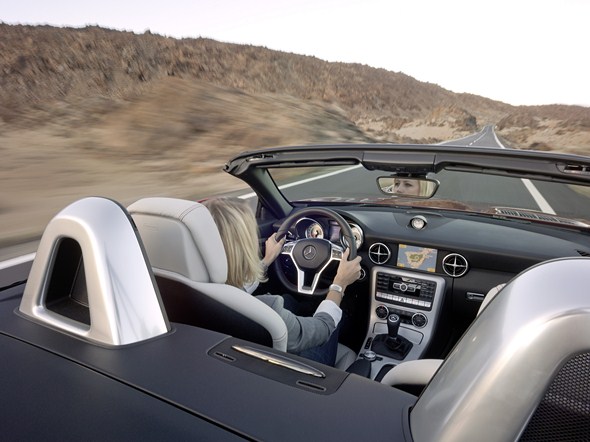
Communication and entertainment
A mood-maker and constant helper
A radio and other entertainment media are a matter of course in today’s vehicles, electronic navigation systems have meanwhile almost as common, and it must be possible to integrate a mobile phone easily into the onboard network. To meet these requirements in the best possible way, Mercedes-Benz has equipped the new SLK with latest-generation telematics.
The top-of-the-range COMAND Online is even internet-capable, and enables the driver to enjoy the benefits of the World Wide Web in the car.
The high performance of the head units available is immediately apparent from the large colour display. This monitor is positioned in the upper section of the centre console, so that the driver is able to see the information provided without taking his eyes fully off the road. It can also be easily viewed by the passenger.
All the head units also share a common control unit known as the “controller”. In the interests of relaxed and ergonomical operation, it is located within easy reach in front of the centre armrest. This extremely sophisticated, metal rotary/pressure control can be moved in eight directions, and can also activate or confirm additional functions by rotating or pressing it.
Navigating through the main menus and sub-menus is effortless and easy, and thanks to new, user-friendly logic the system is quickly and intuitively mastered.
Head units available for the new SLK
- Audio 20 CD,
- COMAND Online.
The head units are connected to eight loudspeakers and feature speed-sensitive volume control from 20 km/h, which increases the radio volume with the vehicle speed. All the units are also protected against theft by electronic assignment to the specific vehicle.
Audio 20 CD
The basic Audio 20 CD radio is combined with a large TFT colour display with a screen diagonal of 14.7 centimetres and a resolution of 400 x 240 pixels as a head unit. Audio 20 features
- integrated FM twin tuner,
- audio amplifier with 4×25 watts,
- MP3-capable CD player or optionally a 6-disc CD changer and
AUX connection in the glove compartment, as well as - a Bluetooth interface for hands-free telephoning.
Available for the first time, the Becker® MAP PILOT upgrades the basic Audio 20 radio into a fully-fledged navigation unit. The additional unit contains the GPS receiver and the processor required for navigation. The colour map and additional information are shown on the colour display of the Audio 20 head unit, and the Becker® MAP PILOT’s acoustic driving recommendations are issued via the onboard loudspeakers.
The driver is also able to have a direction arrow and distance information shown in the multifunction display of the instrument cluster. The navigation has a clearly laid-out user interface and can be operated intuitively using the central controller in front of the centre armrest.
Data covering Europe are pre-installed in the Becker® MAP PILOT. It offers the latest navigation technology, and includes the following features:
- map-based navigation including 3D view,
- lane recommendation,
- display of speed limits for many roads, as well as other traffic information,
- information on the remaining distance, ETA or street names,
- address input possible with a single voice command,
- calculation of the most economical route (fuel savings through an ideal compromise between travel time and fuel consumption),
- display of alternative routes,
- TMC for dynamic tailback avoidance,
- display of brand logos to mark special destinations such as filling stations or restaurants,
- map and functional software updates plus other features and services available via the internet, and additional map updates available from dealers on SD memory cards.
The Becker® MAP PILOT is fitted into the glove compartment, and can be easily removed at any time. Updating the map material via a PC and the internet therefore presents no problems.
It is also possible to order a pre-installation kit for the Becker® MAP PILOT ex factory, without the unit itself.
COMAND Online – onboard internet access
On request Mercedes-Benz will equip the new SLK with a COMAND Online head unit using the voice-operated control system LINGUATRONIC. The control and information interface for this unit is a high-resolution TFT colour display with a 17.8 cm screen diagonal capable of representing 800 x 480 pixels.
The COMAND Online multimedia system offers internet access for the first time. Customers can either surf freely on the internet when at a standstill or to a Mercedes-Benz online service while driving; the latter’s pages can be called up particularly quickly and it is simple to operate.
The integral services planned include Google™ Local Search and further online services from other suppliers such as the weather. It is also possible to send individual destinations and routes to the vehicle via Google Maps. More Mercedes-Benz online services will be introduced gradually and then all customers will be able to use them.
The high-resolution colour display measures 17.8 cm. Photos can be shown on the large screen and turned over manually, as in a slide show. Where the audio equipment is concerned, too, new types of representation bring a fresh look and more convenient operation.
The new Cover Flow function, for instance, sorts the title images of the music albums stored in a carousel-like form, so that the SLK driver can easily leaf through their music collection – even if it is rather on the large side: the memory for compressed audio files (mp3, wma and aac formats) now comprises as much as 10 GB. As an option COMAND Online is available with a 6-disc DVD changer.
Greatest convenience is afforded by the Music Search function, which enables drivers and passengers to search the hard disc, SD memory cards, USB sticks, CDs and DVDs for specific music tracks and artists. The search can be according to various criteria, for instance album, music category or composer.
If a name needs to be entered, the software will also tolerate spelling mistakes. The driver is therefore able to devote their full attention to the traffic. As a further advantage, the occupants are able to search all the connected media and devices simultaneously.
The fast hard-disc navigation system of COMAND Online also has added functions. New features include a 3D display with plastic city views. Also new: routes covered can be recorded and repeated later, specific personal destinations can be imported via an SD card and four alternative routes can be displayed on the navigation map, one of them a particularly economical variation.
Mercedes-Benz customers in Europe receive the current maps for their COMAND Online multimedia system free of charge for three years. The authorised Mercedes-Benz dealers upload the updates for navigation data in 39 European countries into the navigation system when the customer visits their premises.
In Europe COMAND Online also comprises the Speed Limit Assist, which receives its information for traffic sign recognition via a camera and navigation database. COMAND Online also includes the LINGUATRONIC voice-operated control system for audio, telephone and navigation. The new “One Shot” input for the navigation is particularly convenient, whereby the place and road can be said directly after one another.
COMAND Online is also equipped with the following features:
- internet browser,
- FM radio twin tuner with additional RDS/TMC tuner for traffic information,
- audio signal amplifier 4 x 25 W,
- DVD player for audio and video (optionally also with 6-disc DVD changer),
- integrated navigation system with map display (including birdview, 3D map and 3D landmarks),
- integrated hard disc for navigation data and additional functions (e.g. music server); this means that the DVD player is available to play music during a journey,
- SD card slot.
The voice-operated control system LINGUATRONIC enables all town and street names to be input into the navigation system by voice command. The audio systems can also be voice-controlled, and the global address book accessed. LINGUATRONIC recognises commands without prior training, and these can be entered by any speaker. The system prompts the user to repeat the process if it detects an error or fails to recognise a command.
Naturally the COMAND Online system can also be combined with the convenience telephony function.
Sound system – striking the right note
Customers who attach importance to a quality of sound approaching concert-hall standards in the SLK are able to choose the optional Harman/Kardon® surround sound system for either Audio 20 CD or COMAND Online. This features an additional MOST amplifier with DSP and an output of 10 x 50 watts plus eleven high-quality, high-performance loudspeakers.
All the amplifier channels of the sound system are equipped with frequency compensation individually suited to the vehicle acoustics. Bass, treble, volume, balance and fader can be individually adjusted.
Aerials – first-class reception
The radio reception aerials are integrated into the windscreen, with their aerial amplifiers in the A-pillar area. A so-called phase diversity function obtains the maximum reception strength from both aerial signals. To this end it mainly reduces interference caused by multi-channel reception (interference due to reflections). The maximum specifications include:
- two FM aerials in the windscreen for the diversity functionality,
- an AM aerial in the rear window or parcel shelf/roof compartment cover,
- an aerial for the telephone/GPS and DAB L-band (digital radio)
Telephony – reachable at any time
Both the Audio 20 CD radio and the COMAND Online system have an integrated hands-free system for mobile phones using a Bluetooth interface. Even in the basic telephony version, the hands-free system can be operated via the multifunction steering wheel and the keys on the head unit.
Bluetooth can also be used to transfer contact data from a mobile phone to the head unit. SMS messages can also be downloaded if the mobile phone supports MAP (Message Access Profile).
A convenience telephony function is also available as an optional extra, and this can likewise be combined with all available head units. It consists of a phone cradle for the centre console with a phone charging function, and uses the vehicle aerial via a serial interface. A cradle suitable for the relevant phone model is separately available as a Mercedes-Benz accessory.
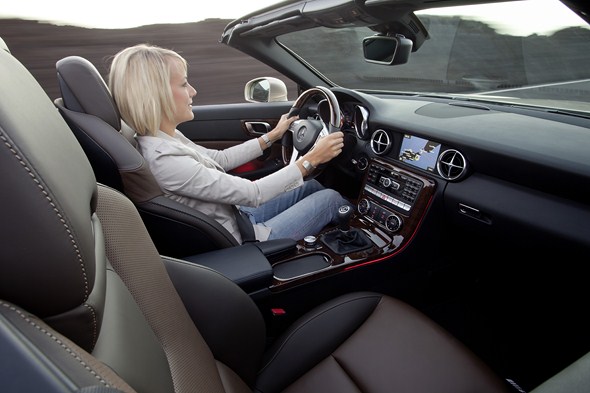
AMG Sports package Power made apparent
Even in the base version, the new SLK has an eye-catching appearance with its exciting design, stature and high-class interior. Even more dynamic highlights can be added with the optional AMG Sports package.
The AMG Bodystyling package adds a further sporty and businesslike touch. This includes a muscular front apron, prominent side skirts and a new rear apron that suggests sheer power. Headlamps with dark surrounds and dark-tinted tail lights provide further visual distinctions.
The seats with their specific vertical fluting and red topstitching emphasise their sporty nature, and are also available in grey as an alternative. There is also red topstitching on the door armrests (if an Exclusive nappa leather interior is specified, also on the centre armrest, the upper dashboard section and the beltlines), the leather gaiter on the shift/selector lever and the steering wheel with its grippy, perforated leather.
Red seat belts provide yet another visual highlight. In models with the 7G-TRONIC PLUS automatic transmission, steering wheel shift paddles facilitate sporty gearshifts.
An instrument cluster in a “chequered flag” design, black velour floor mats with red piping and the AMG logo round off the exclusive interior.
The technical basis for models with the AMG Sports package is provided by a lowered sports suspension with a stiffer, sportier spring and damper setup. Contact with the road surface is established by 18-inch 5-twin-spoke high-sheen light-alloy wheels with mixed-size tyres (front 225/40, rear 245/35) from sports car specialist AMG.
A braking system with perforated 17-inch brake discs and callipers bearing the lettering “Mercedes-Benz” ensures outstanding deceleration.
The four-cylinder roadsters equipped with the AMG Sports package also express their special character acoustically – with an even sportier engine sound.
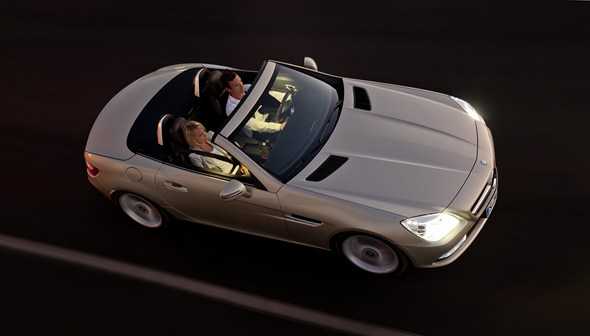
The “small” roadsters from Mercedes-Benz
Evolution of sheer driving pleasure – from the 190 SL to the SLK
The new Mercedes-Benz SLK features a new, exciting design, exceptionally high levels of comfort for a roadster, as well as exquisite technology and no shortage of open-air driving pleasure. As such, the agile sports car already in its third generation looks set to continue a success story which started back in 1994, with a show car.
Strictly speaking, however, the pedigree of the SLK stretches back even further – to the 190 SL, a vehicle which automotive enthusiasts were already dreaming about in 1955 as the economic upturn was starting in the Federal Republic of Germany.
When the SLK appeared as a series-produced car in 1996, it not only caused a stir on the road but also established a new market segment which has since grown by leaps and bounds. With the steel vario-roof, which transforms the roadster into an all-weather coupé within a matter of seconds, the roadster has been and still is the role model for many open-top cars.
The success of the SLK has exceeded all expectations: to date, well over half a million owners have been delighted with their purchase of an SLK Roadster.
The 190 SL – a new star in the automotive firmament in 1955
With the SLK, Mercedes-Benz continued its roadster tradition which stretches back a long way. Its direct ancestor is considered to be the 190 SL, which owes its existence primarily to the perseverance of Maximilian Edwin Hoffman.
The enterprising American with Austrian roots was importing European cars into the USA as early as 1946, and in doing so demonstrated infallible instinct and tremendous flair. In 1953 he urged the executive board of Daimler-Benz to build a more affordable sports car, in addition to the 300 SL, for the American market.
As an elegant sports car from a well-known company featuring an exciting design at a low price, the 190 SL was designed to charm the Americans.
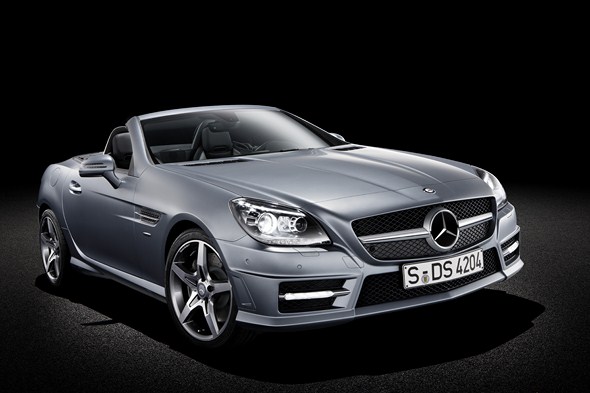
After a development period of just five months, on 6 February 1954 the 190 SL celebrated its world premiere in New York, alongside the legendary 300 SL “gullwing”.
Unlike the 300 SL, the 190 SL was not designed as a thoroughbred sports car but rather as a sporty, elegant two-seater touring and utility vehicle. Its chassis was the shortened frame floor assembly from the 180, combined with the single-joint swing axle with lowered centre of rotation, as used in the 220.
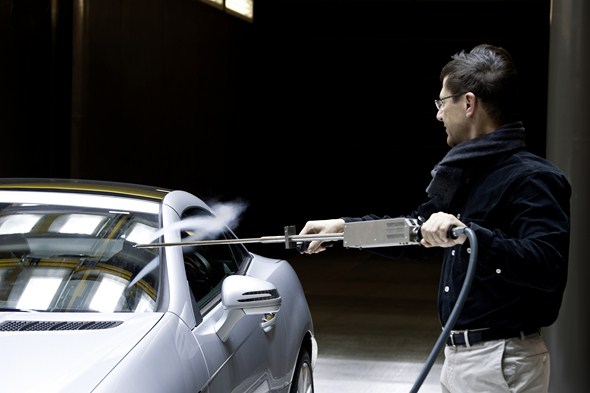
The front-wheel suspension, including subframe design, came from the 180 / 180 D models. The 190 SL was driven by a newly developed four-cylinder engine with a displacement of 1.9 litres, overhead camshaft and output of 105 hp. Depending on conditions it could therefore reach a speed significantly exceeding 170 km/h, and accelerated from 0 to 100 km/h in 14 seconds.
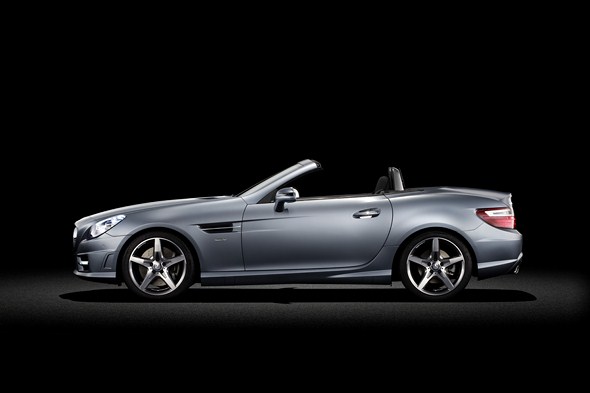
Series production started in May 1955. The 190 SL was available as a roadster with soft top as well as a coupé with removable hard top, with or without a soft top as an option. A broad range of prominent social figures chose this elegant sports car to complement their image, including Grace Kelly and Frank Sinatra, who drove a 190 SL in the film “Ten Thousand Bedrooms”.
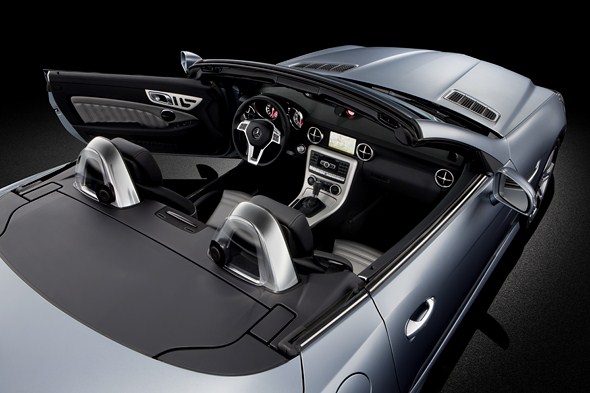
The Mercedes-Benz 190 SL was built up until 1963. The clearest indication of just how much loved and successful the 190 SL was is demonstrated by the production figures: between May 1955 and February 1963, no less than 25,881 cars left the assembly lines in Sindelfingen – far in excess of the initial aspirations.
Two studies for the new type of roadster
Against this historical backdrop, it seemed only logical some decades later to revisit these considerations: would it not perhaps be appropriate for the SL-Class Mercedes-Benz models, now firmly established in their own right, to be joined by a younger brother? After all, Mercedes-Benz had launched an entirely new product initiative, to which a compact roadster could lend fresh emphasis by drawing attention to the sporting heart of the Mercedes-Benz brand.
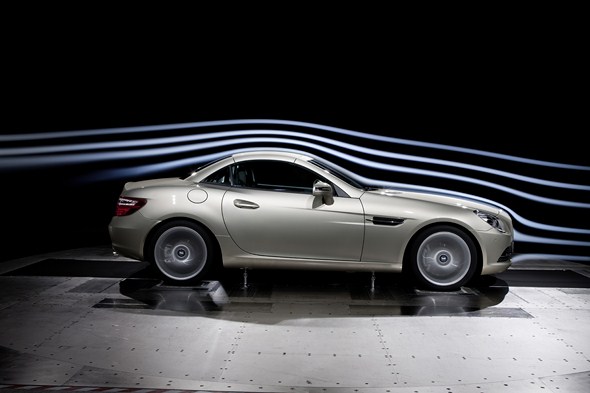
An appropriate acronym for this newcomer was swiftly coined: SLK. In German, these three letters stand for the car’s characteristic properties – sporty, lightweight and short – and, given the great sporting successes of Mercedes-Benz back in the 1920’s and 1930’s, they have an almost mystical resonance.
In Turin in April 1994, roadster enthusiasts were able to gain a first glimpse of how Mercedes-Benz believed a compact roadster should look. A brilliant silver showstopper with a distinct aura of spartan sportiness sent the trade professionals into raptures.
Bruno Sacco, Head of Design for the brand at the time, made it clear what the company’s aim was: “We are exhibiting a forward-looking roadster study which delivers a unique synthesis of purist motoring pleasure with all the safety features for which Mercedes cars are renowned”.
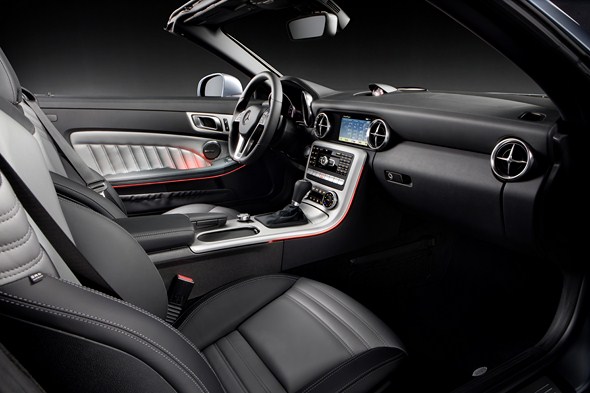
To meet these requirements, some formal individuality was called for. TheSLK study reflected this thanks to its compact dimensions and some evident highlights. Short overhangs at the front and rear, as well as a distinctive wedge shape, embodied the enjoyment to be had from a hands-on driving experience.
And the two “power domes” on the bonnet, running parallel to the direction of travel, were acknowledgement of the originator of all SL’s dating from the 1950s. The SLK study revealed a lot of gleaming metal. Only 20 percent of the interior was covered, and the high-tech cockpit was dominated by bold shapes and high-quality materials.
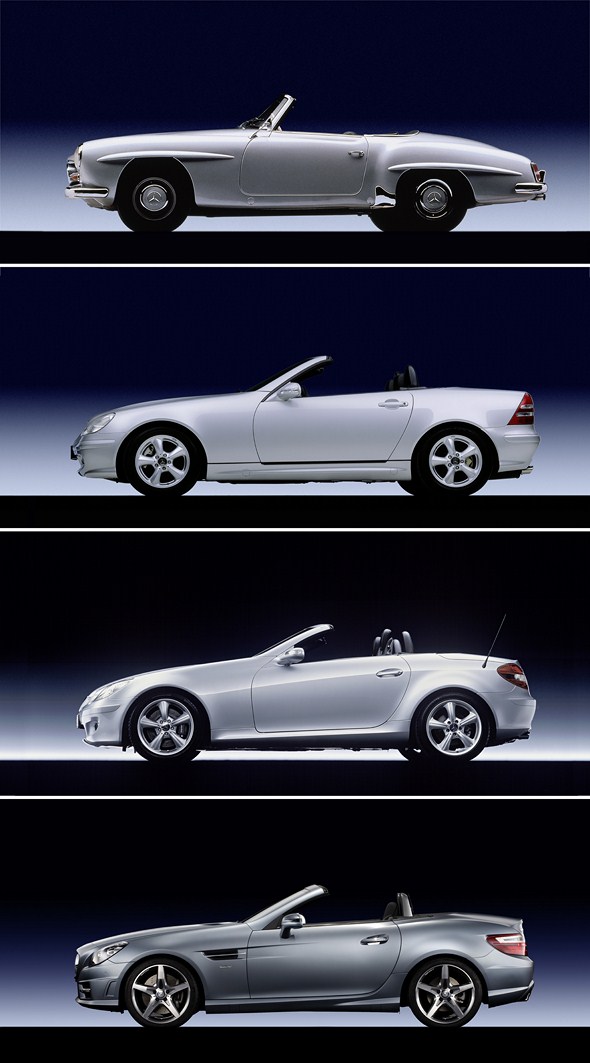
To find out just how seriously the people in charge at Mercedes-Benz were taking this SLK project in its earliest days, one needs to look no further than the Paris Motor Show held in September of the same year. Here the company unveiled its second study, this time with a vario-roof and in the form of a customised version in blue, with blue-tone leather and a range of additional luxury accessories such as automatic transmission, air-conditioning system, power windows, a hi-fi sound system and much more besides. This enabled Mercedes-Benz to demonstrate convincingly the breadth of appeal and the potential inherent in a compact roadster.
The SLK sets the trend before going into series production
Then the automotive enthusiasts started to wait. Many viewed the SLK as a very auspicious prospect indeed. Mercedes-Benz had done the unexpected and demonstrated that a small and relatively inexpensive roadster was capable of offering a great deal of motoring pleasure while still being an absolutely serious and down-to-earth car in terms of safety and quality.
This meant that the roadster studies had already opened up a new market niche, making the SLK a trendsetter even before series production had begun.
By 1996 everything was in place: the series production version of the new SLK, designated internally as the R 170, was launched at the Turin Motor Show. Especially high levels of interest were shown in the fully-lowering steel vario-roof, which substantively backed up the SLK claim to being a car for all weathers.
Using an intelligent electro-hydraulic system, the entire roof folded down into the boot in just 25 seconds, leaving the owner free to roam under an open sky.
The SLK also fielded a convincing range of other qualities. Take safety for example: two fixed roll-over bars behind the seats protected occupants from injury if the car should overturn and, in conjunction with the exceptionally robust A-pillars, delivered a very high level of safety even when these Mercedes-Benz cars are driven with the top down.
Engines from 136 to 354 hp
The sporting talent of the SLK was unleashed by two engine variants: a 2 litre four-cylinder engine with a power rating of 100 kW (136 hp) and a supercharged 2.3 litre engine, also a four-cylinder unit, delivering 142 kW (193 hp). In early 2000, the two litre engine was also fitted with a belt-driven supercharger, boosting power to the rear axle to a new level of 120 kW (163 hp).
The choice of engines was broadened by the arrival of two six-cylinder models, the 160 kW (218 hp) unit for the SLK 320 and the 260 kW (354 hp) powerplant in the SLK 32 AMG.
The evolution of the SLK continues
In February 2000, Mercedes-Benz substantially upgraded the level of equipment for its roadster and incorporated innovations such as the Electronic Stability Program (ESP®) and a six-speed manual transmission into its standard equipment package. In visual terms, a new bumper and side skirts gave the car an even more dynamic appearance.
All the attachments and door handles were painted to match the vehicle body, to enable the whole car to present an image of a unified whole in terms of both colour and form. New tail lights, stainless steel trim on the exhaust tailpipe and a painted radiator grille gave the SLK design an even more commanding identity.
Even more driving pleasure with the second generation SLK
In the spring of 2004, the second generation of the SLK (internal model series designation: R 171) was launched – offering more sportiness and dynamism, and even more driving pleasure. Thanks to powerful engines, a newly developed chassis, direct steering and a precise six-speed shift mechanism, the second generation of the SLK provided an even more responsive driving experience.
As a world first, Mercedes-Benz introduced the AIRSCARF neck-level heating system. At the touch of a button, it generates warm air which flows from the head restraints. This now meant that drivers of the SLK were able to enjoy open-top driving and the open-air roadster experience all year round, even when outside temperatures dropped.
The operating mechanism for the vario-roof was modified. The rear window now rotated in its frame, so that its concave side was uppermost when the roof was folded. This enabled the luggage capacity to be increased.
True to the principle of ongoing development, in 2008 the SLK underwent a comprehensive facelift.
The most significant visual changes included redesigned front and rear sections and also a carefully modified interior with new instrument cluster and three-spoke sports steering wheel. The distinctive dynamic character of the two-seater was brought to the fore to particularly good effect in the SLK 350 courtesy of a high-revving V6 sports engine producing 224 kW (305 hp) along with an optional Direct-Steer system. In addition, despite their significantly increased performance, all of the engines were more economical in terms of fuel consumption.
The new SLK once again sets standards
The new SLK which will be presented in January 2011, and designated internally as the R 172, will follow in these same footsteps. Partly thanks to new engines with the ECO start/stop function, the roadster consumes significantly less fuel, thus demonstrating that achieving pure driving pleasure while maintaining a clear conscience when it comes to the environment do not necessarily have to be conflicting principles.
The new SLK combines nimble-footed sportiness with stylish comfort, a striking sports car design with absolute suitability for everyday use, and top-of-the-range performance with exemplary ecology. In addition, a unique series of safety equipment enables the SLK to assume the role of benchmark in this segment. Standard equipment also includes the ATTENTION ASSIST drowsiness detection system.
Mercedes-Benz will also be the world’s first automotive manufacturer to offer the panoramic vario-roof with MAGIC SKY CONTROL as an optional extra. With this innovation, the transparent glass roof can be darkened in a matter of seconds at the touch of a button.
Other options include a Dynamic Handling package with continuously variable damping incl. Direct-Steer and the Torque Vectoring Brake, or the Intelligent Light System with various lighting functions. Thanks to such a rich array of technical innovations, the SLK will once more set the standard in its class.
Model history: the Mercedes-Benz SLK
1994
– In April, Mercedes-Benz displays the compact roadster as a study vehicle at the Turin Motor Show
– In September a second study vehicle is unveiled, this time with vario-roof and in the form of a customised version
1996
World premiere of the SLK at the Turin Motor Show
2000
The SLK undergoes a comprehensive facelift
2004
World premiere of the second generation of the SLK at the Geneva Motor Show
2008
Facelift for the second generation of the SLK
2011
Third generation of the SLK
